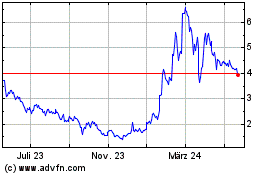false000178222300017822232024-11-202024-11-20
UNITED STATES
SECURITIES AND EXCHANGE COMMISSION
WASHINGTON, D.C. 20549
FORM 8-K
CURRENT REPORT
Pursuant to Section 13 or 15(d) of the Securities Exchange Act of 1934
|
Date of Report (Date of earliest event reported): November 20, 2024 |
Pyxis Oncology, Inc.
(Exact name of Registrant as Specified in Its Charter)
|
|
|
|
|
Delaware |
001-40881 |
83-1160910 |
(State or Other Jurisdiction
of Incorporation) |
(Commission File Number) |
(IRS Employer
Identification No.) |
|
|
|
|
|
321 Harrison Avenue |
|
Boston, Massachusetts |
|
02118 |
(Address of Principal Executive Offices) |
|
(Zip Code) |
|
Registrant’s Telephone Number, Including Area Code: (617)221-9059 |
(Former Name or Former Address, if Changed Since Last Report)
Check the appropriate box below if the Form 8-K filing is intended to simultaneously satisfy the filing obligation of the registrant under any of the following provisions:
☐Written communications pursuant to Rule 425 under the Securities Act (17 CFR 230.425)
☐Soliciting material pursuant to Rule 14a-12 under the Exchange Act (17 CFR 240.14a-12)
☐Pre-commencement communications pursuant to Rule 14d-2(b) under the Exchange Act (17 CFR 240.14d-2(b))
☐Pre-commencement communications pursuant to Rule 13e-4(c) under the Exchange Act (17 CFR 240.13e-4(c))
Securities registered pursuant to Section 12(b) of the Act:
|
|
|
|
|
Title of each class
|
|
Trading
Symbol(s) |
|
Name of each exchange on which registered
|
Common Stock, par value $0.001 per share |
|
PYXS |
|
The Nasdaq Global Select Market |
Indicate by check mark whether the registrant is an emerging growth company as defined in Rule 405 of the Securities Act of 1933 (§ 230.405 of this chapter) or Rule 12b-2 of the Securities Exchange Act of 1934 (§ 240.12b-2 of this chapter).
Emerging growth company ☒
If an emerging growth company, indicate by check mark if the registrant has elected not to use the extended transition period for complying with any new or revised financial accounting standards provided pursuant to Section 13(a) of the Exchange Act. ☒
Item 7.01 Regulation FD Disclosure
On November 20, 2024, Pyxis Oncology, Inc. (the “Company”) provided a corporate update and issued a press release announcing positive initial dose escalation data from the ongoing Phase 1 clinical study evaluating PYX-201 in multiple types of solid tumors. A copy of the corporate presentation is attached as Exhibit 99.1. and the press release is attached as Exhibit 99.2 to this Current Report on Form 8-K.
The information furnished under this Item 7.01, including Exhibit 99.1, shall not be deemed “filed” for purposes of Section 18 of the Securities Exchange Act of 1934, as amended (the “Exchange Act”), or otherwise subject to the liabilities of that section, nor shall it be deemed incorporated by reference in any filing under the Securities Act of 1933, as amended, or the Exchange Act, except as expressly set forth by specific reference in such a filing.
Item 9.01 Financial Statements and Exhibits.
SIGNATURES
Pursuant to the requirements of the Securities Exchange Act of 1934, the registrant has duly caused this report to be signed on its behalf by the undersigned thereunto duly authorized.
|
|
|
|
|
|
|
Pyxis Oncology, Inc. |
|
|
|
|
Date: |
November 20, 2024 |
By: |
/s/ Pamela Connealy |
|
|
|
Pamela Connealy
Chief Financial Officer and Chief Operating Officer |
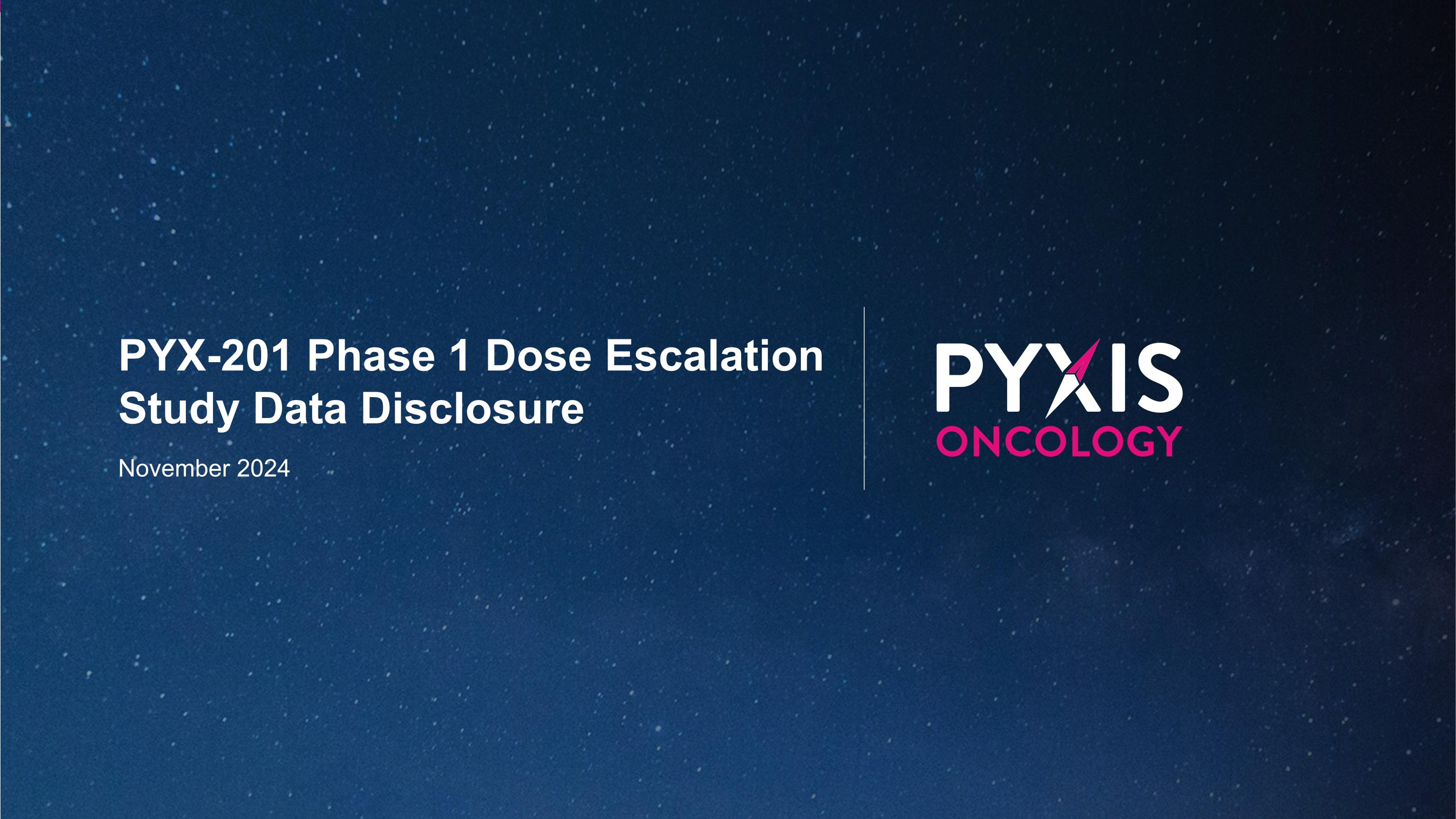
PYX-201 Phase 1 Dose Escalation Study Data Disclosure November 2024
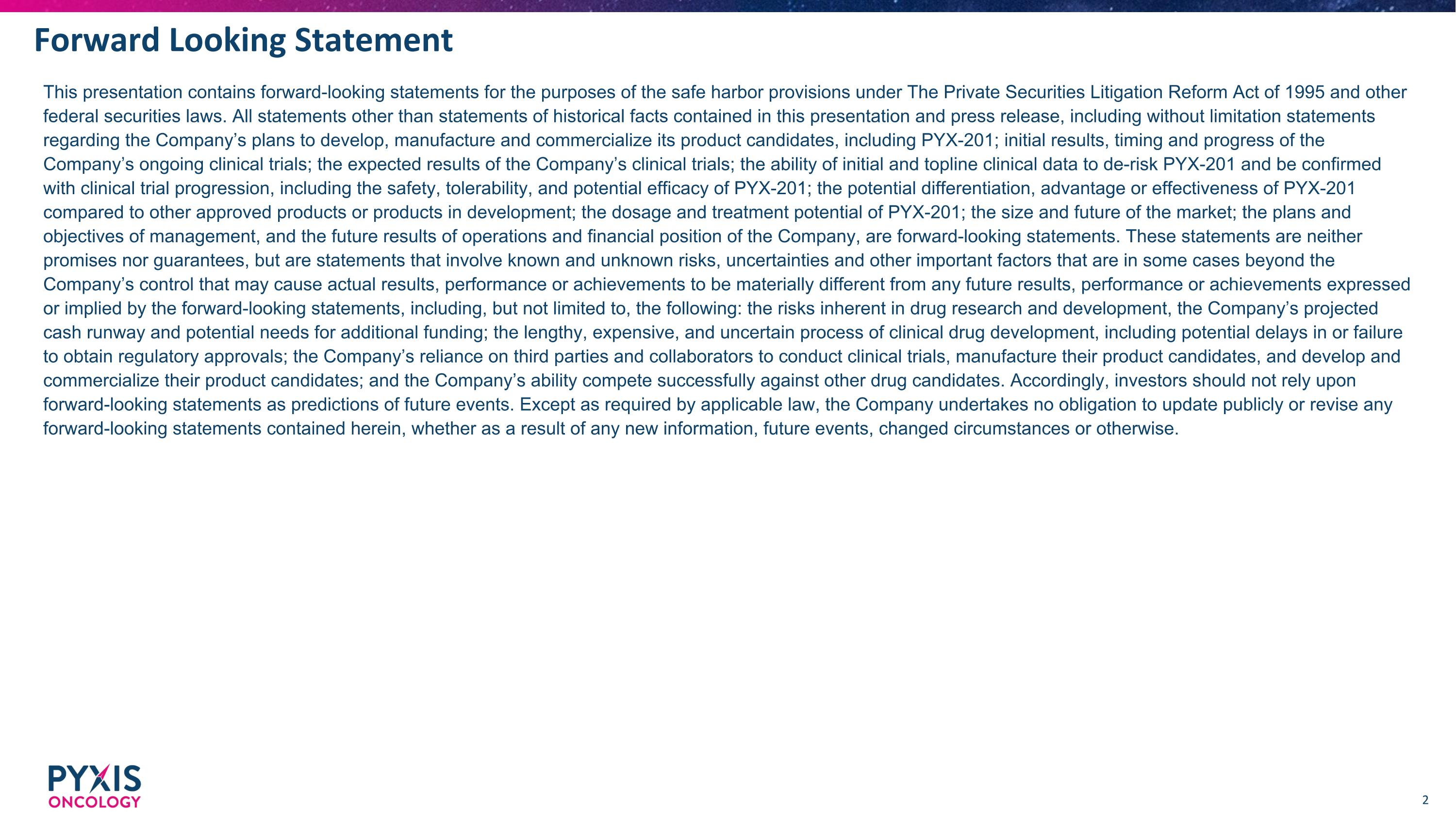
Forward Looking Statement This presentation contains forward-looking statements for the purposes of the safe harbor provisions under The Private Securities Litigation Reform Act of 1995 and other federal securities laws. All statements other than statements of historical facts contained in this presentation and press release, including without limitation statements regarding the Company’s plans to develop, manufacture and commercialize its product candidates, including PYX-201; initial results, timing and progress of the Company’s ongoing clinical trials; the expected results of the Company’s clinical trials; the ability of initial and topline clinical data to de-risk PYX-201 and be confirmed with clinical trial progression, including the safety, tolerability, and potential efficacy of PYX-201; the potential differentiation, advantage or effectiveness of PYX-201 compared to other approved products or products in development; the dosage and treatment potential of PYX-201; the size and future of the market; the plans and objectives of management, and the future results of operations and financial position of the Company, are forward-looking statements. These statements are neither promises nor guarantees, but are statements that involve known and unknown risks, uncertainties and other important factors that are in some cases beyond the Company’s control that may cause actual results, performance or achievements to be materially different from any future results, performance or achievements expressed or implied by the forward-looking statements, including, but not limited to, the following: the risks inherent in drug research and development, the Company’s projected cash runway and potential needs for additional funding; the lengthy, expensive, and uncertain process of clinical drug development, including potential delays in or failure to obtain regulatory approvals; the Company’s reliance on third parties and collaborators to conduct clinical trials, manufacture their product candidates, and develop and commercialize their product candidates; and the Company’s ability compete successfully against other drug candidates. Accordingly, investors should not rely upon forward-looking statements as predictions of future events. Except as required by applicable law, the Company undertakes no obligation to update publicly or revise any forward-looking statements contained herein, whether as a result of any new information, future events, changed circumstances or otherwise.
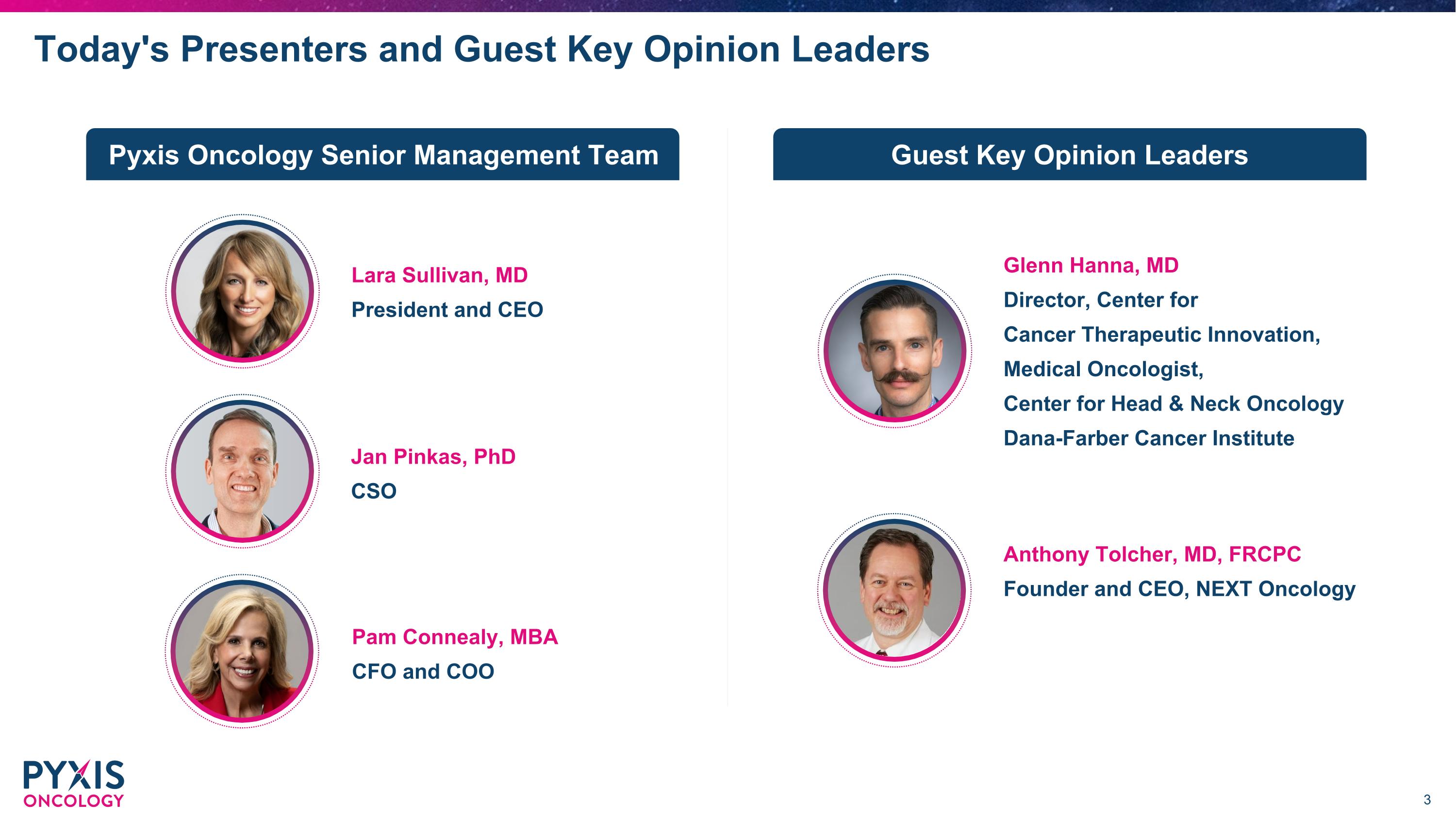
Today's Presenters and Guest Key Opinion Leaders Lara Sullivan, MD President and CEO Pam Connealy, MBA CFO and COO Jan Pinkas, PhD CSO Pyxis Oncology Senior Management Team Glenn Hanna, MD Director, Center for Cancer Therapeutic Innovation, Medical Oncologist, Center for Head & Neck Oncology Dana-Farber Cancer Institute Anthony Tolcher, MD, FRCPC Founder and CEO, NEXT Oncology Guest Key Opinion Leaders
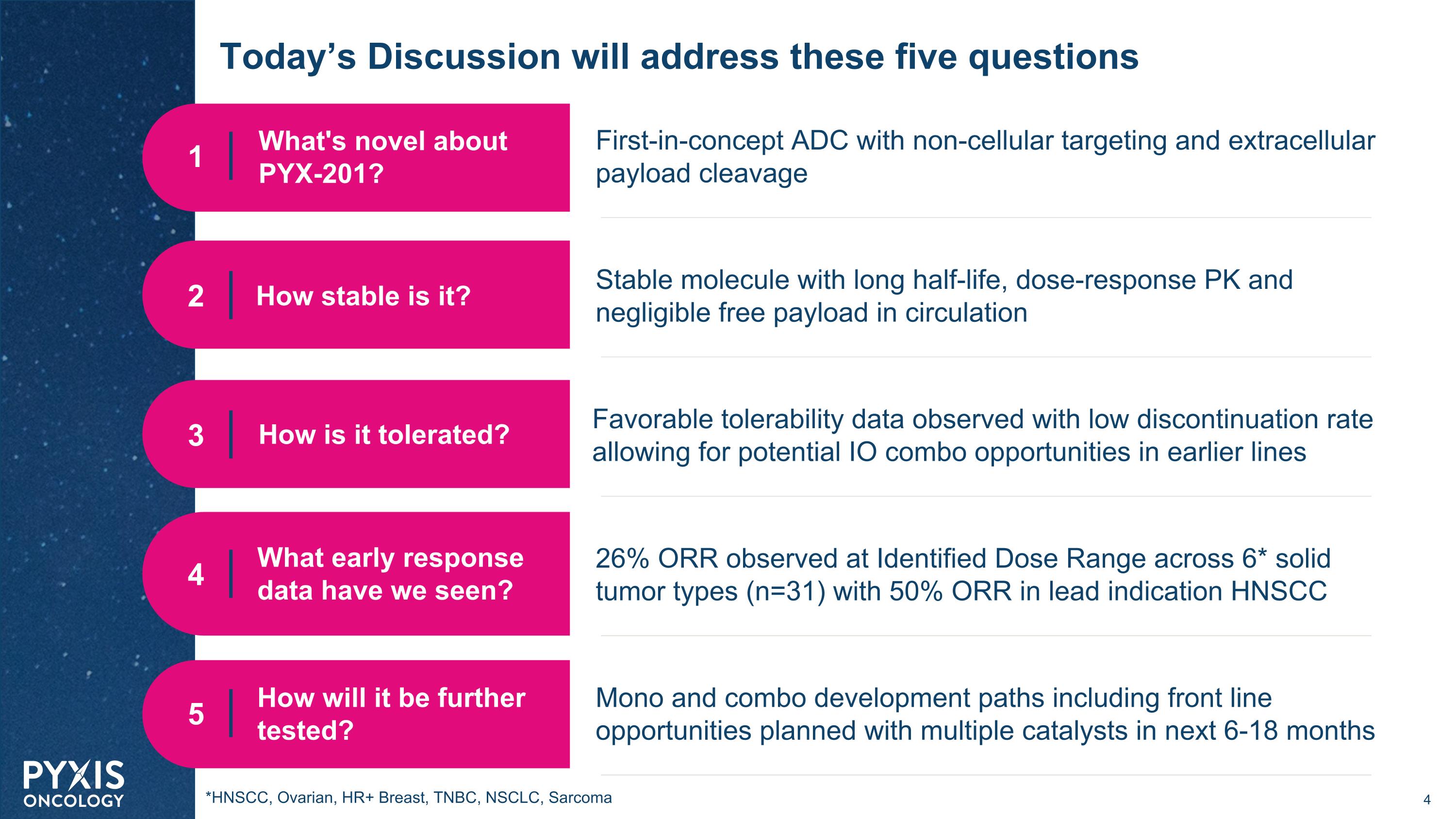
Today’s Discussion will address these five questions What's novel about PYX-201? How stable is it? How is it tolerated? What early response data have we seen? How will it be further tested? 1 2 3 4 5 First-in-concept ADC with non-cellular targeting and extracellular payload cleavage Stable molecule with long half-life, dose-response PK and negligible free payload in circulation Favorable tolerability data observed with low discontinuation rate allowing for potential IO combo opportunities in earlier lines 26% ORR observed at Identified Dose Range across 6* solid tumor types (n=31) with 50% ORR in lead indication HNSCC Mono and combo development paths including front line opportunities planned with multiple catalysts in next 6-18 months *HNSCC, Ovarian, HR+ Breast, TNBC, NSCLC, Sarcoma
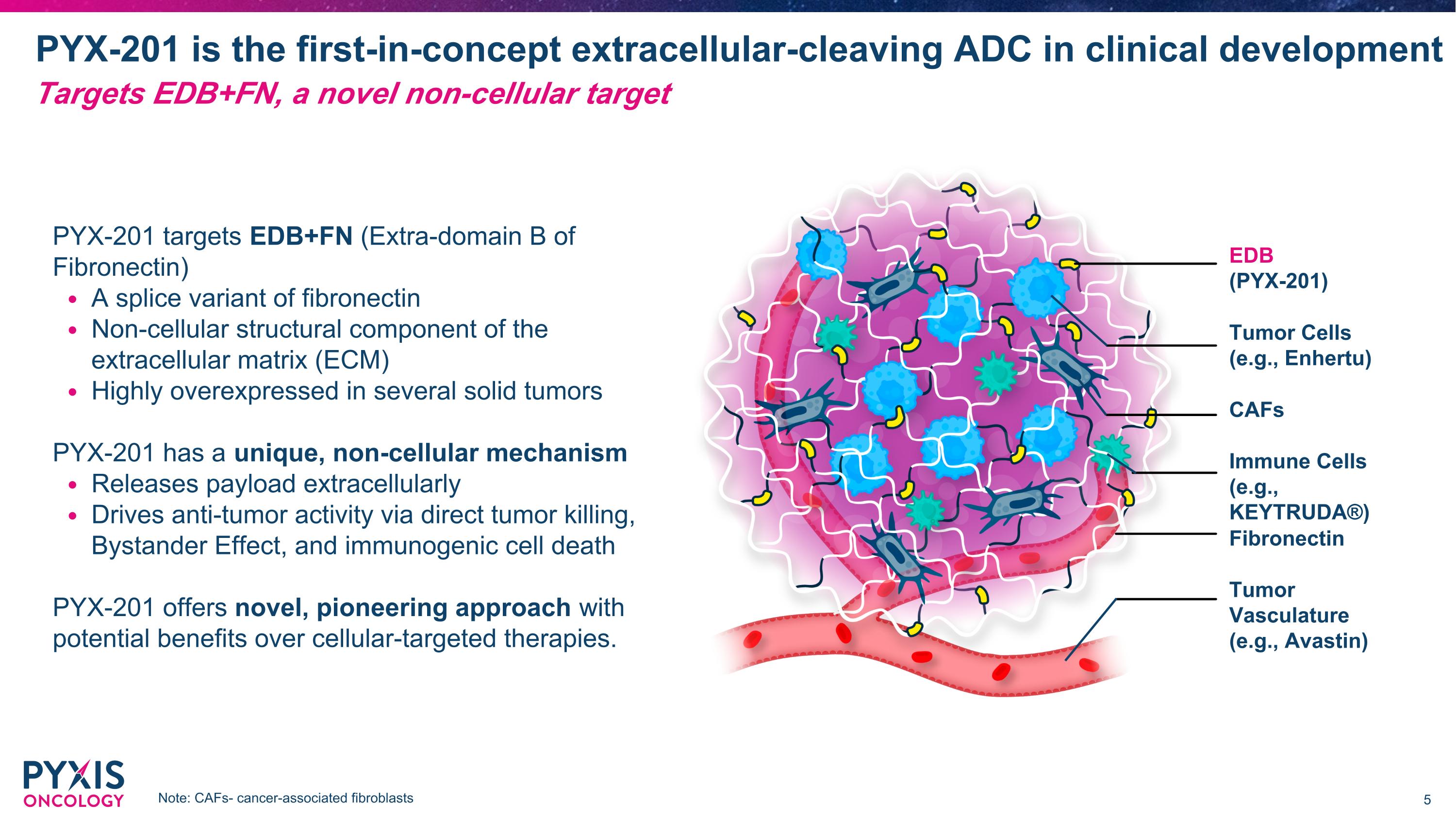
PYX-201 is the first-in-concept extracellular-cleaving ADC in clinical development PYX-201 targets EDB+FN (Extra-domain B of Fibronectin) A splice variant of fibronectin Non-cellular structural component of the extracellular matrix (ECM) Highly overexpressed in several solid tumors PYX-201 has a unique, non-cellular mechanism Releases payload extracellularly Drives anti-tumor activity via direct tumor killing, Bystander Effect, and immunogenic cell death PYX-201 offers novel, pioneering approach with potential benefits over cellular-targeted therapies. Note: CAFs- cancer-associated fibroblasts Tumor Vasculature (e.g., Avastin) Fibronectin CAFs EDB (PYX-201) Immune Cells (e.g., KEYTRUDA®) Tumor Cells (e.g., Enhertu) Targets EDB+FN, a novel non-cellular target
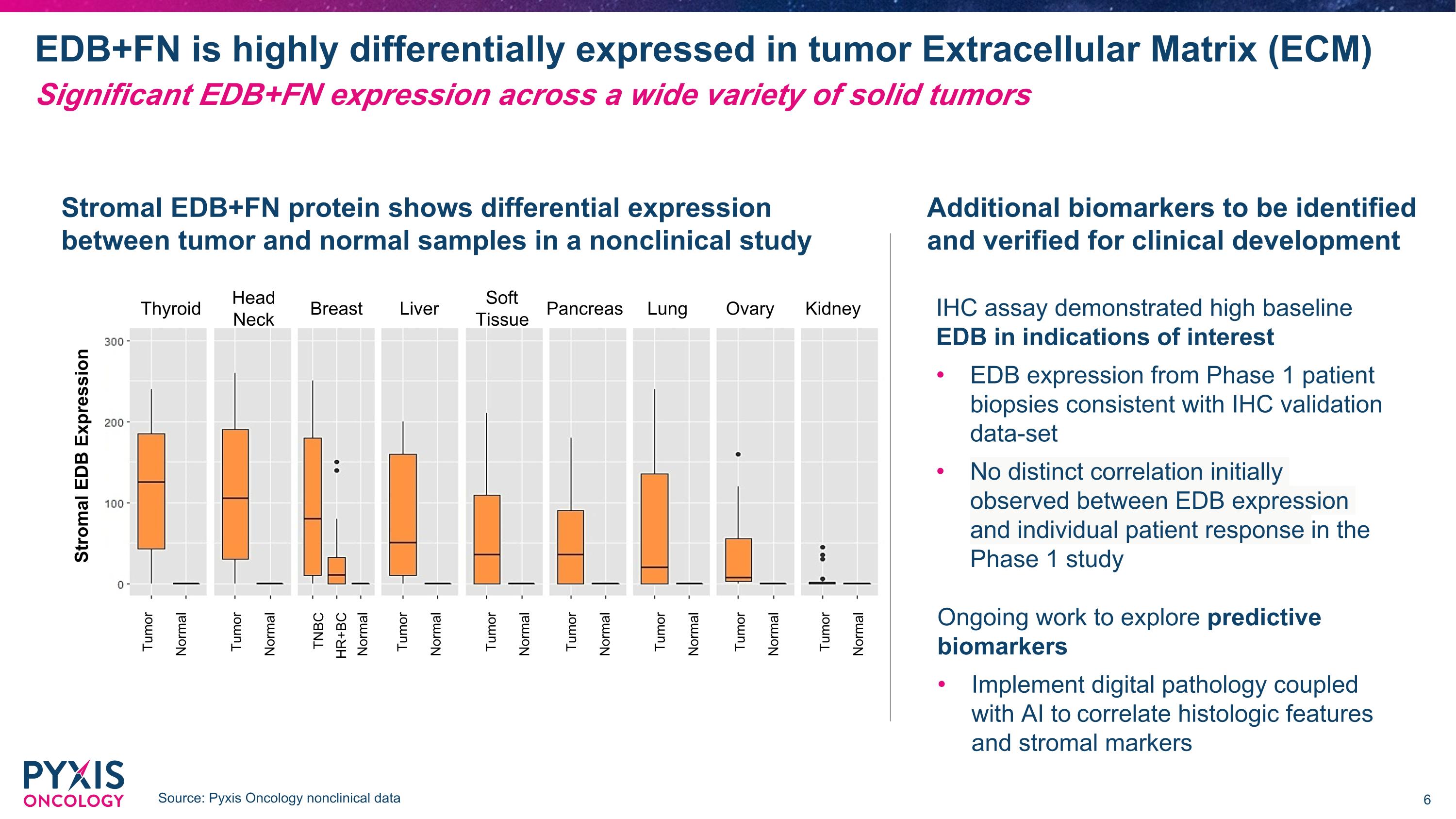
EDB+FN is highly differentially expressed in tumor Extracellular Matrix (ECM) Source: Pyxis Oncology nonclinical data IHC assay demonstrated high baseline EDB in indications of interest EDB expression from Phase 1 patient biopsies consistent with IHC validation data-set No distinct correlation initially observed between EDB expression and individual patient response in the Phase 1 study Ongoing work to explore predictive biomarkers Implement digital pathology coupled with AI to correlate histologic features and stromal markers Stromal EDB Expression Tumor Normal Tumor Normal TNBC Normal HR+BC Tumor Normal Tumor Normal Tumor Normal Tumor Normal Tumor Normal Tumor Normal Thyroid Head Neck Breast Liver Soft Tissue Lung Ovary Kidney Stromal EDB+FN protein shows differential expression between tumor and normal samples in a nonclinical study Pancreas Additional biomarkers to be identified and verified for clinical development Significant EDB+FN expression across a wide variety of solid tumors
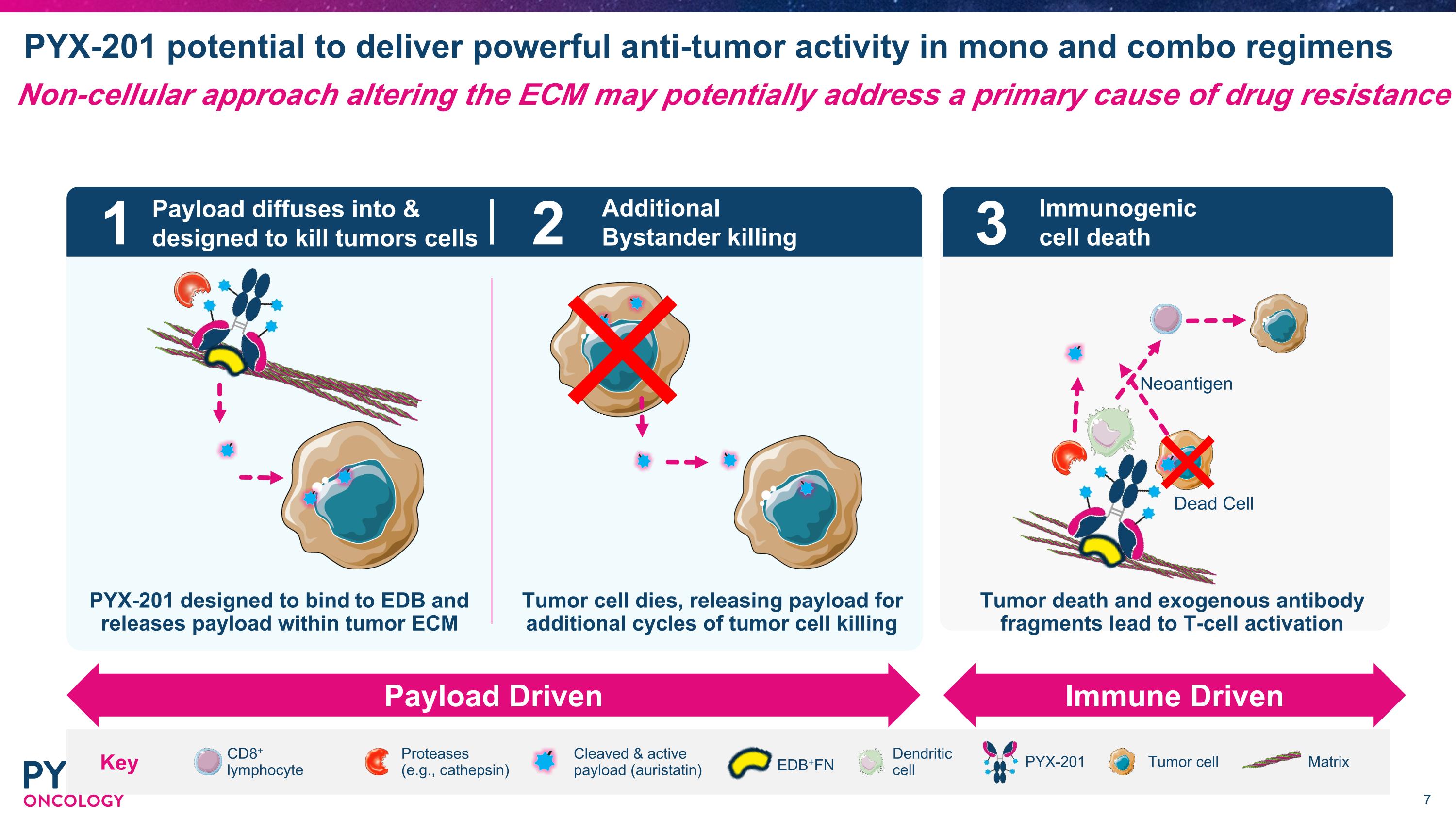
PYX-201 potential to deliver powerful anti-tumor activity in mono and combo regimens PYX-201 designed to bind to EDB and releases payload within tumor ECM CD8+ lymphocyte Dendritic �cell PYX-201 Cleaved & active payload (auristatin) Tumor cell Matrix Proteases (e.g., cathepsin) Key 1 2 3 Payload diffuses into & designed to kill tumors cells Additional Bystander killing Immunogenic cell death Payload Driven Immune Driven Dead Cell Neoantigen Tumor cell dies, releasing payload for additional cycles of tumor cell killing Tumor death and exogenous antibody fragments lead to T-cell activation EDB+FN Non-cellular approach altering the ECM may potentially address a primary cause of drug resistance
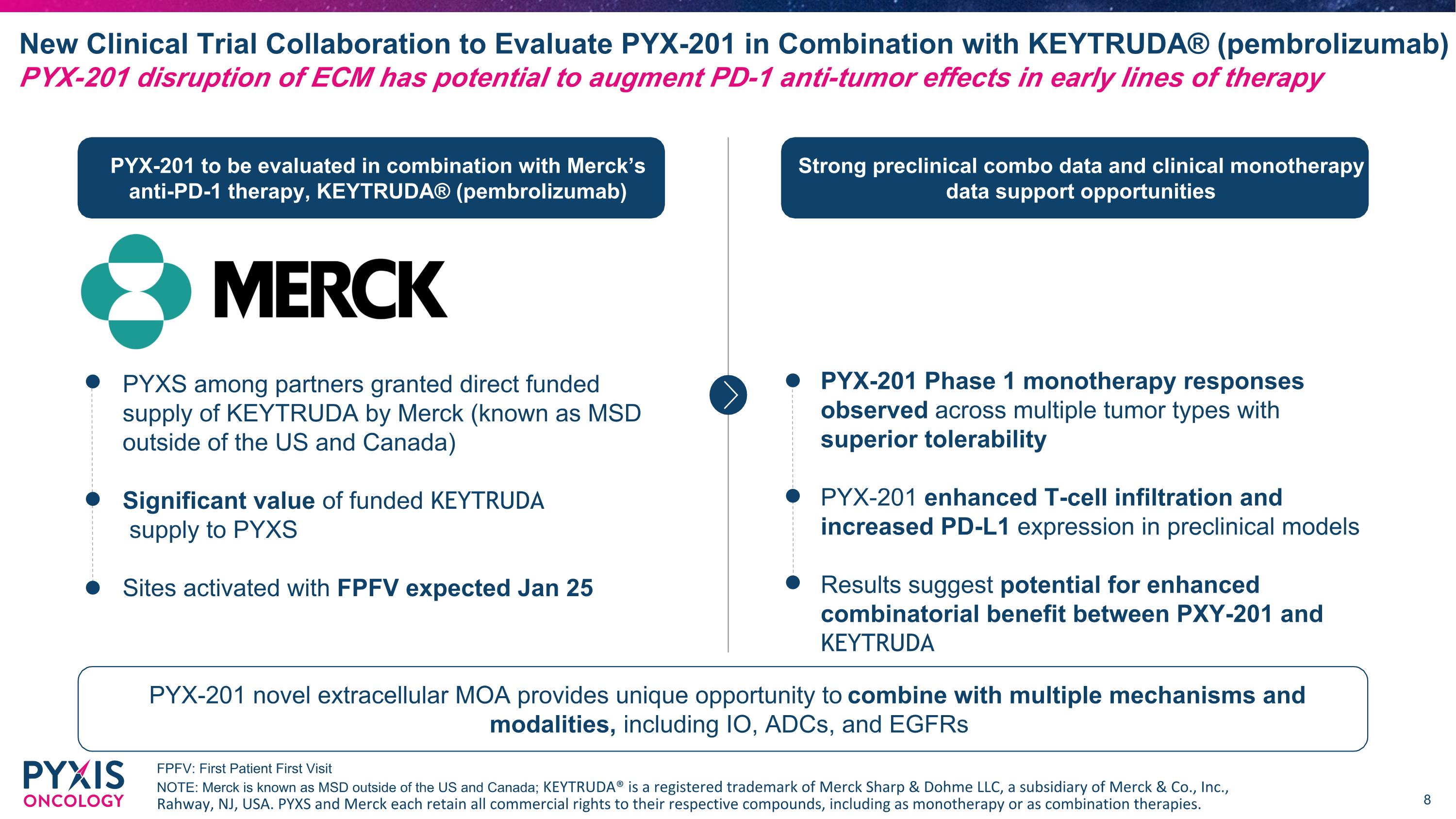
New Clinical Trial Collaboration to Evaluate PYX-201 in Combination with KEYTRUDA® (pembrolizumab)�PYX-201 disruption of ECM has potential to augment PD-1 anti-tumor effects in early lines of therapy FPFV: First Patient First Visit NOTE: Merck is known as MSD outside of the US and Canada; KEYTRUDA® is a registered trademark of Merck Sharp & Dohme LLC, a subsidiary of Merck & Co., Inc., Rahway, NJ, USA. PYXS and Merck each retain all commercial rights to their respective compounds, including as monotherapy or as combination therapies. PYX-201 to be evaluated in combination with Merck’s anti-PD-1 therapy, KEYTRUDA® (pembrolizumab) Strong preclinical combo data and clinical monotherapy data support opportunities PYX-201 novel extracellular MOA provides unique opportunity to combine with multiple mechanisms and modalities, including IO, ADCs, and EGFRs PYXS among partners granted direct funded supply of KEYTRUDA by Merck (known as MSD outside of the US and Canada) Significant value of funded KEYTRUDA supply to PYXS Sites activated with FPFV expected Jan 25 PYX-201 Phase 1 monotherapy responses observed across multiple tumor types with superior tolerability PYX-201 enhanced T-cell infiltration and increased PD-L1 expression in preclinical models Results suggest potential for enhanced combinatorial benefit between PXY-201 and KEYTRUDA
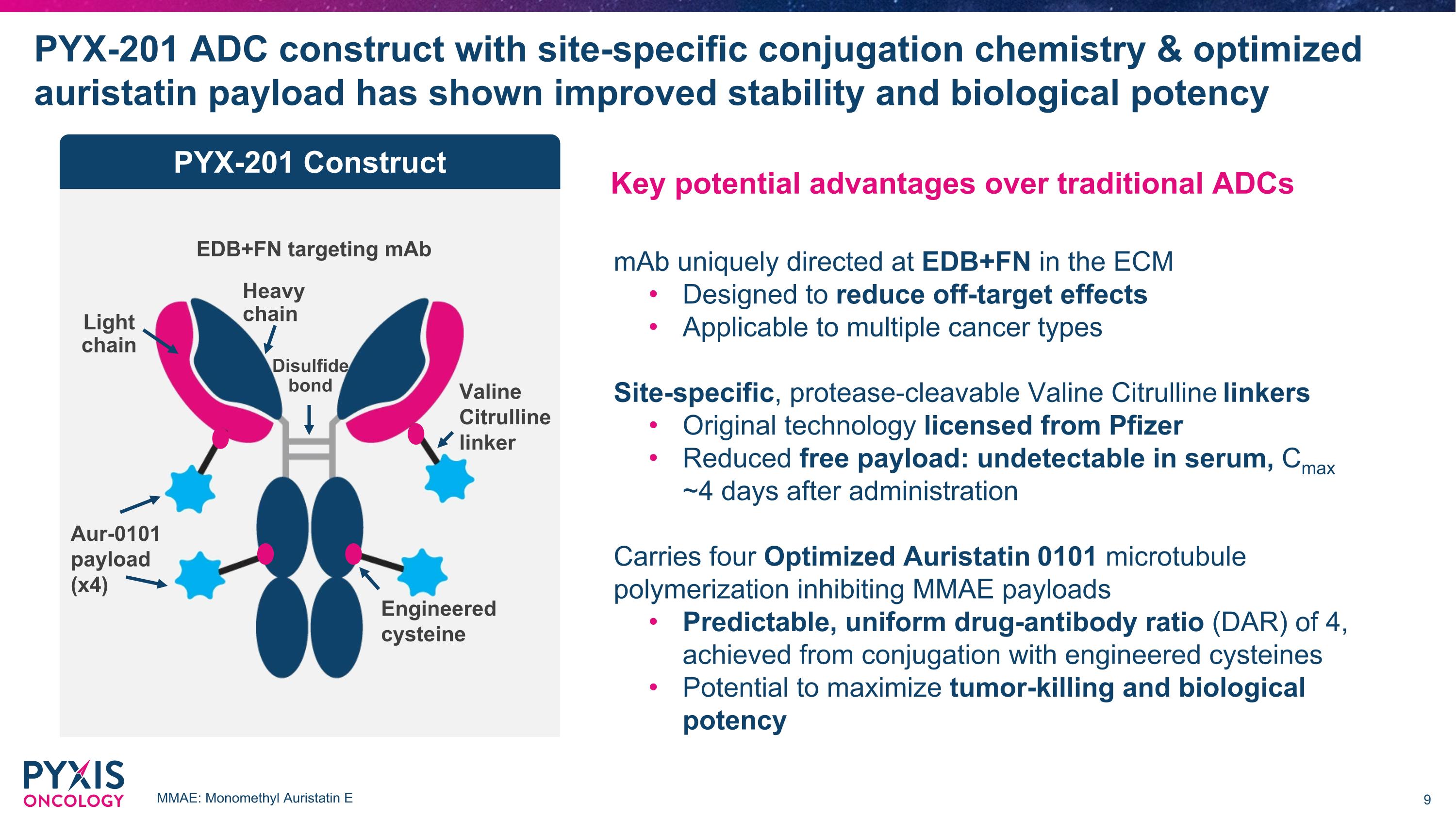
PYX-201 ADC construct with site-specific conjugation chemistry & optimized auristatin payload has shown improved stability and biological potency EDB+FN targeting mAb Aur-0101 payload (x4) Valine Citrulline linker PYX-201 Construct Light chain Heavy chain Engineered cysteine Disulfide bond Key potential advantages over traditional ADCs mAb uniquely directed at EDB+FN in the ECM Designed to reduce off-target effects Applicable to multiple cancer types Site-specific, protease-cleavable Valine Citrulline linkers Original technology licensed from Pfizer Reduced free payload: undetectable in serum, Cmax ~4 days after administration Carries four Optimized Auristatin 0101 microtubule polymerization inhibiting MMAE payloads Predictable, uniform drug-antibody ratio (DAR) of 4, achieved from conjugation with engineered cysteines Potential to maximize tumor-killing and biological potency MMAE: Monomethyl Auristatin E
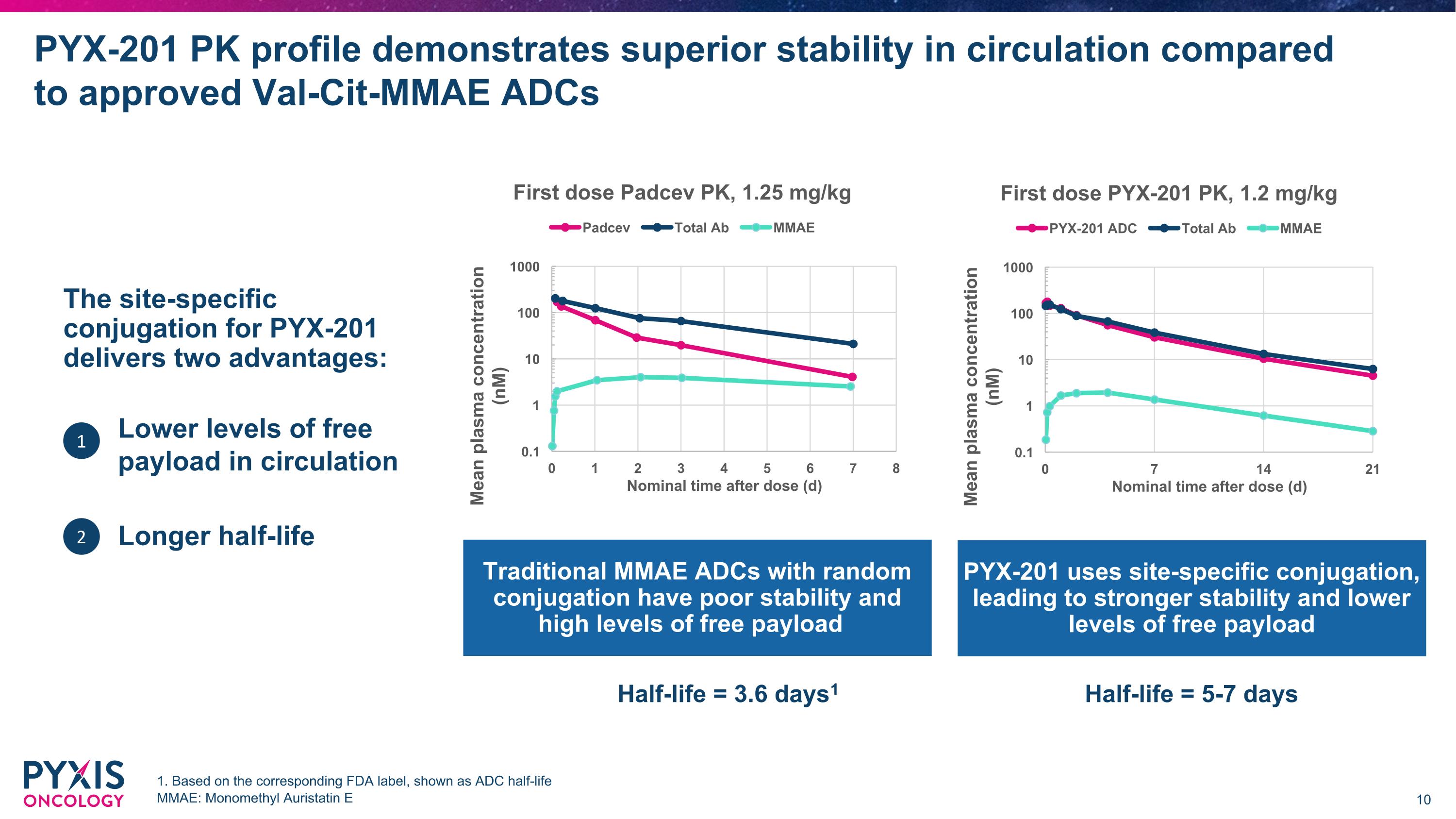
PYX-201 PK profile demonstrates superior stability in circulation compared to approved Val-Cit-MMAE ADCs 1. Based on the corresponding FDA label, shown as ADC half-life MMAE: Monomethyl Auristatin E The site-specific conjugation for PYX-201 delivers two advantages: Lower levels of free payload in circulation Longer half-life 1 2 Traditional MMAE ADCs with random conjugation have poor stability and high levels of free payload PYX-201 uses site-specific conjugation, leading to stronger stability and lower levels of free payload Half-life = 3.6 days1 Half-life = 5-7 days
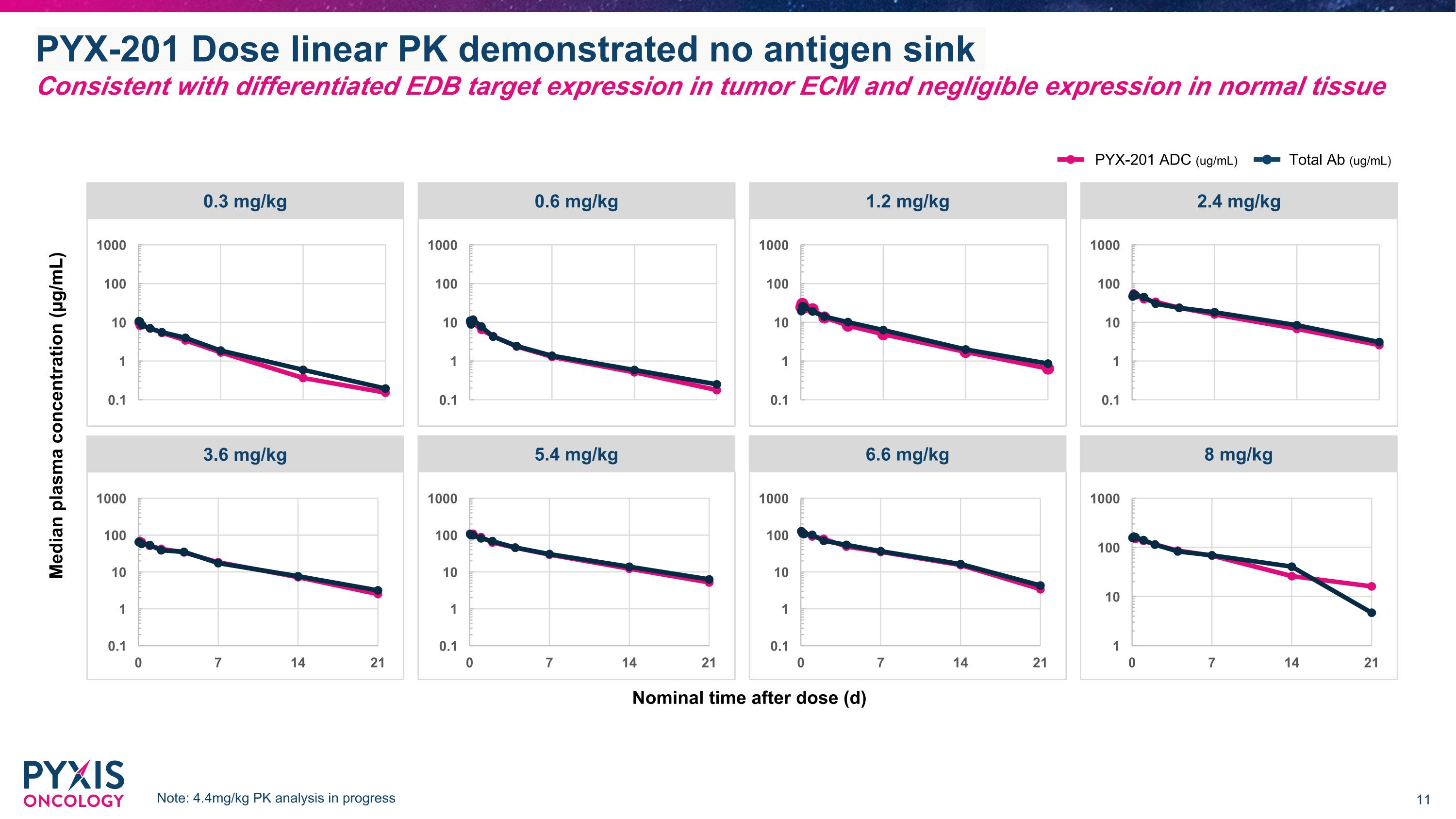
PYX-201 Dose linear PK demonstrated no antigen sink �Consistent with differentiated EDB target expression in tumor ECM and negligible expression in normal tissue Nominal time after dose (d) Median plasma concentration (µg/mL) 0.3 mg/kg 0.6 mg/kg 1.2 mg/kg 2.4 mg/kg 3.6 mg/kg 5.4 mg/kg 6.6 mg/kg 8 mg/kg PYX-201 ADC (ug/mL) Total Ab (ug/mL) Note: 4.4mg/kg PK analysis in progress
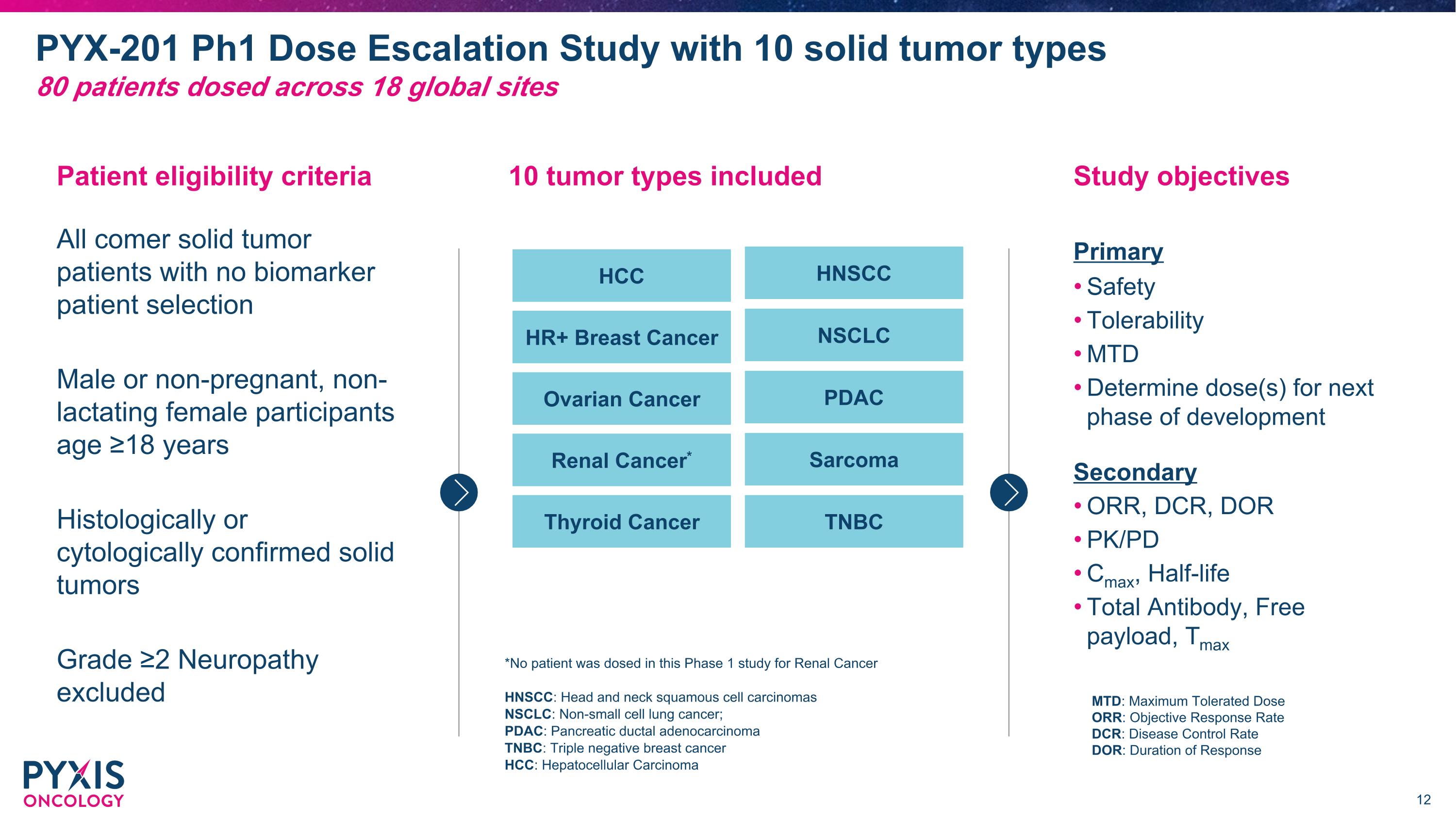
PYX-201 Ph1 Dose Escalation Study with 10 solid tumor types *No patient was dosed in this Phase 1 study for Renal Cancer HNSCC: Head and neck squamous cell carcinomas NSCLC: Non-small cell lung cancer; PDAC: Pancreatic ductal adenocarcinoma TNBC: Triple negative breast cancer HCC: Hepatocellular Carcinoma Patient eligibility criteria All comer solid tumor patients with no biomarker patient selection Male or non-pregnant, non-lactating female participants age ≥18 years Histologically or cytologically confirmed solid tumors Grade ≥2 Neuropathy excluded 10 tumor types included 80 patients dosed across 18 global sites Study objectives Safety Tolerability MTD Determine dose(s) for next phase of development Primary ORR, DCR, DOR PK/PD Cmax, Half-life Total Antibody, Free�payload, Tmax Secondary HCC HNSCC HR+ Breast Cancer NSCLC Ovarian Cancer PDAC Renal Cancer* Sarcoma Thyroid Cancer TNBC MTD: Maximum Tolerated Dose ORR: Objective Response Rate DCR: Disease Control Rate DOR: Duration of Response
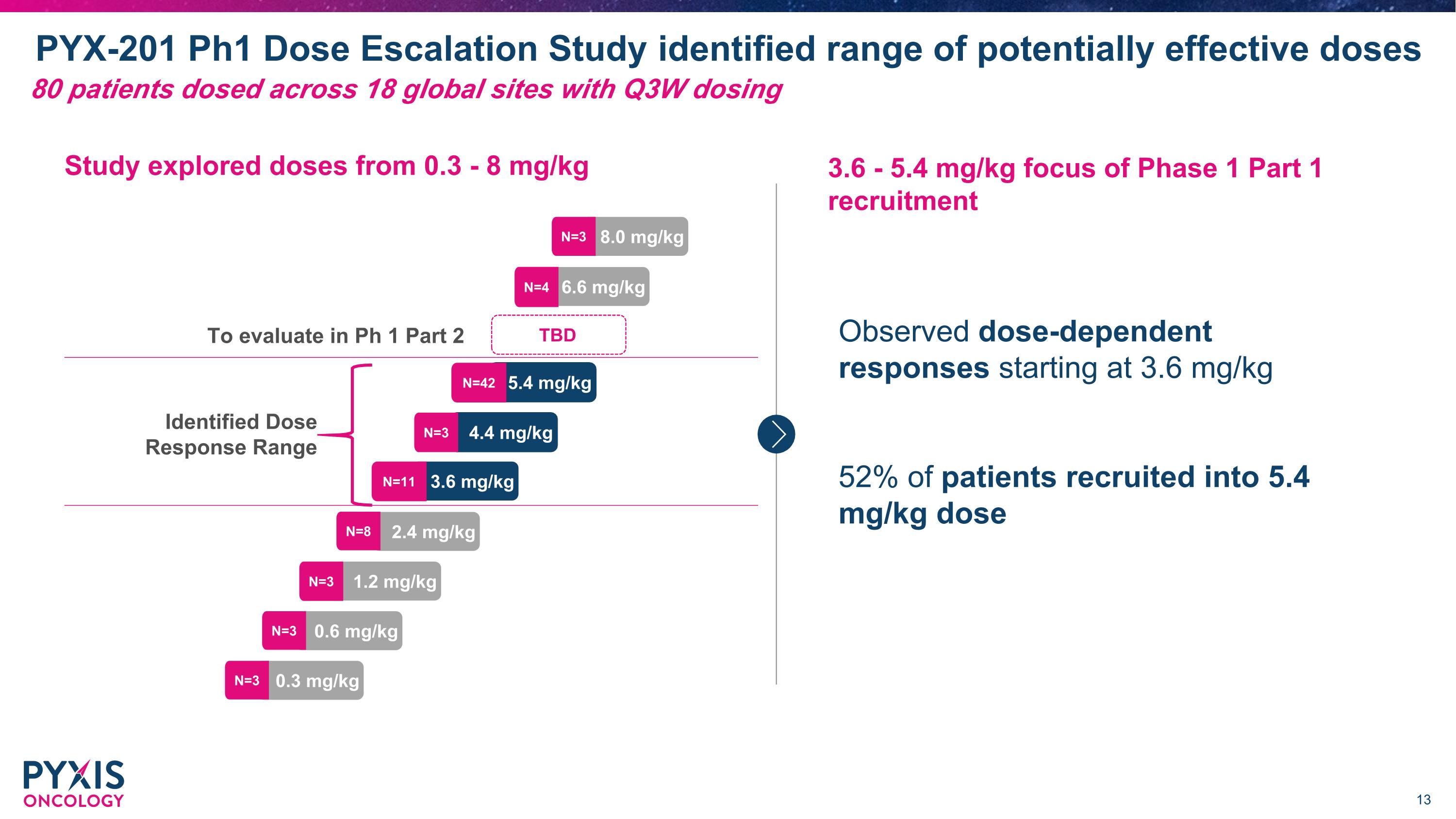
PYX-201 Ph1 Dose Escalation Study identified range of potentially effective doses 0.3 mg/kg 0.6 mg/kg 1.2 mg/kg 2.4 mg/kg 3.6 mg/kg 4.4 mg/kg 5.4 mg/kg 6.6 mg/kg 8.0 mg/kg N=3 N=3 N=3 N=8 N=11 N=42 N=3 N=3 N=4 3.6 - 5.4 mg/kg focus of Phase 1 Part 1 recruitment Observed dose-dependent responses starting at 3.6 mg/kg 52% of patients recruited into 5.4 mg/kg dose Study explored doses from 0.3 - 8 mg/kg TBD Identified Dose Response Range 80 patients dosed across 18 global sites with Q3W dosing To evaluate in Ph 1 Part 2
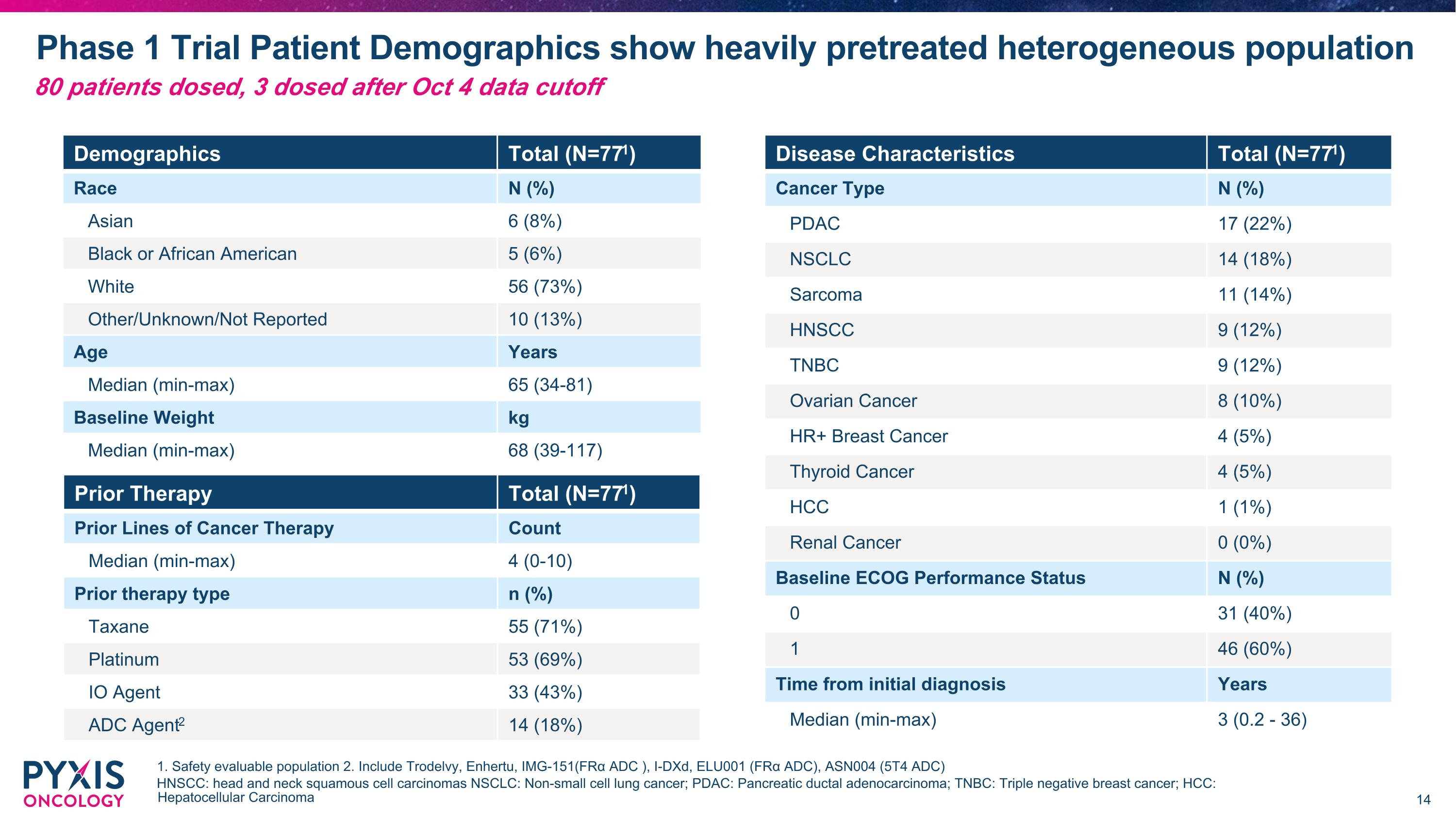
Phase 1 Trial Patient Demographics show heavily pretreated heterogeneous population 1. Safety evaluable population 2. Include Trodelvy, Enhertu, IMG-151(FRα ADC ), I-DXd, ELU001 (FRα ADC), ASN004 (5T4 ADC) HNSCC: head and neck squamous cell carcinomas NSCLC: Non-small cell lung cancer; PDAC: Pancreatic ductal adenocarcinoma; TNBC: Triple negative breast cancer; HCC: Hepatocellular Carcinoma Demographics Total (N=771) Race N (%) Asian 6 (8%) Black or African American 5 (6%) White 56 (73%) Other/Unknown/Not Reported 10 (13%) Age Years Median (min-max) 65 (34-81) Baseline Weight kg Median (min-max) 68 (39-117) Prior Therapy Total (N=771) Prior Lines of Cancer Therapy Count Median (min-max) 4 (0-10) Prior therapy type n (%) Taxane 55 (71%) Platinum 53 (69%) IO Agent 33 (43%) ADC Agent2 14 (18%) Disease Characteristics Total (N=771) Cancer Type N (%) PDAC 17 (22%) NSCLC 14 (18%) Sarcoma 11 (14%) HNSCC 9 (12%) TNBC 9 (12%) Ovarian Cancer 8 (10%) HR+ Breast Cancer 4 (5%) Thyroid Cancer 4 (5%) HCC 1 (1%) Renal Cancer 0 (0%) Baseline ECOG Performance Status N (%) 0 31 (40%) 1 46 (60%) Time from initial diagnosis Years Median (min-max) 3 (0.2 - 36) 80 patients dosed, 3 dosed after Oct 4 data cutoff
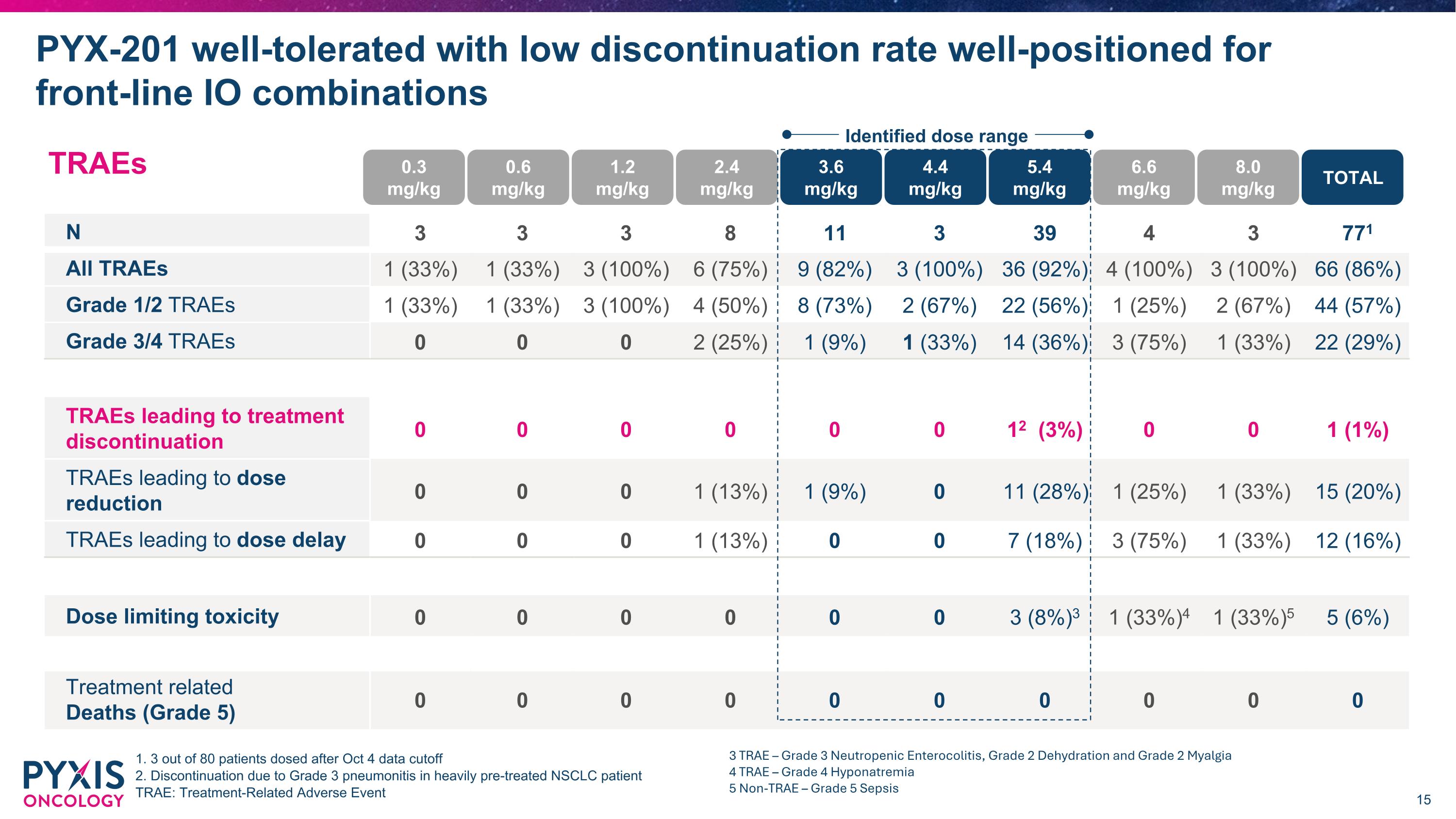
TRAEs N 3 3 3 8 11 3 39 4 3 771 All TRAEs 1 (33%) 1 (33%) 3 (100%) 6 (75%) 9 (82%) 3 (100%) 36 (92%) 4 (100%) 3 (100%) 66 (86%) Grade 1/2 TRAEs 1 (33%) 1 (33%) 3 (100%) 4 (50%) 8 (73%) 2 (67%) 22 (56%) 1 (25%) 2 (67%) 44 (57%) Grade 3/4 TRAEs 0 0 0 2 (25%) 1 (9%) 1 (33%) 14 (36%) 3 (75%) 1 (33%) 22 (29%) TRAEs leading to treatment discontinuation 0 0 0 0 0 0 12 (3%) 0 0 1 (1%) TRAEs leading to dose reduction 0 0 0 1 (13%) 1 (9%) 0 11 (28%) 1 (25%) 1 (33%) 15 (20%) TRAEs leading to dose delay 0 0 0 1 (13%) 0 0 7 (18%) 3 (75%) 1 (33%) 12 (16%) Dose limiting toxicity 0 0 0 0 0 0 3 (8%)3 1 (33%)4 1 (33%)5 5 (6%) Treatment related�Deaths (Grade 5) 0 0 0 0 0 0 0 0 0 0 PYX-201 well-tolerated with low discontinuation rate well-positioned for front-line IO combinations 1. 3 out of 80 patients dosed after Oct 4 data cutoff 2. Discontinuation due to Grade 3 pneumonitis in heavily pre-treated NSCLC patient TRAE: Treatment-Related Adverse Event 0.3�mg/kg 0.6�mg/kg 1.2�mg/kg 2.4�mg/kg 3.6�mg/kg 4.4�mg/kg 5.4�mg/kg 6.6�mg/kg 8.0�mg/kg TOTAL Identified dose range 3 TRAE – Grade 3 Neutropenic Enterocolitis, Grade 2 Dehydration and Grade 2 Myalgia 4 TRAE – Grade 4 Hyponatremia 5 Non-TRAE – Grade 5 Sepsis
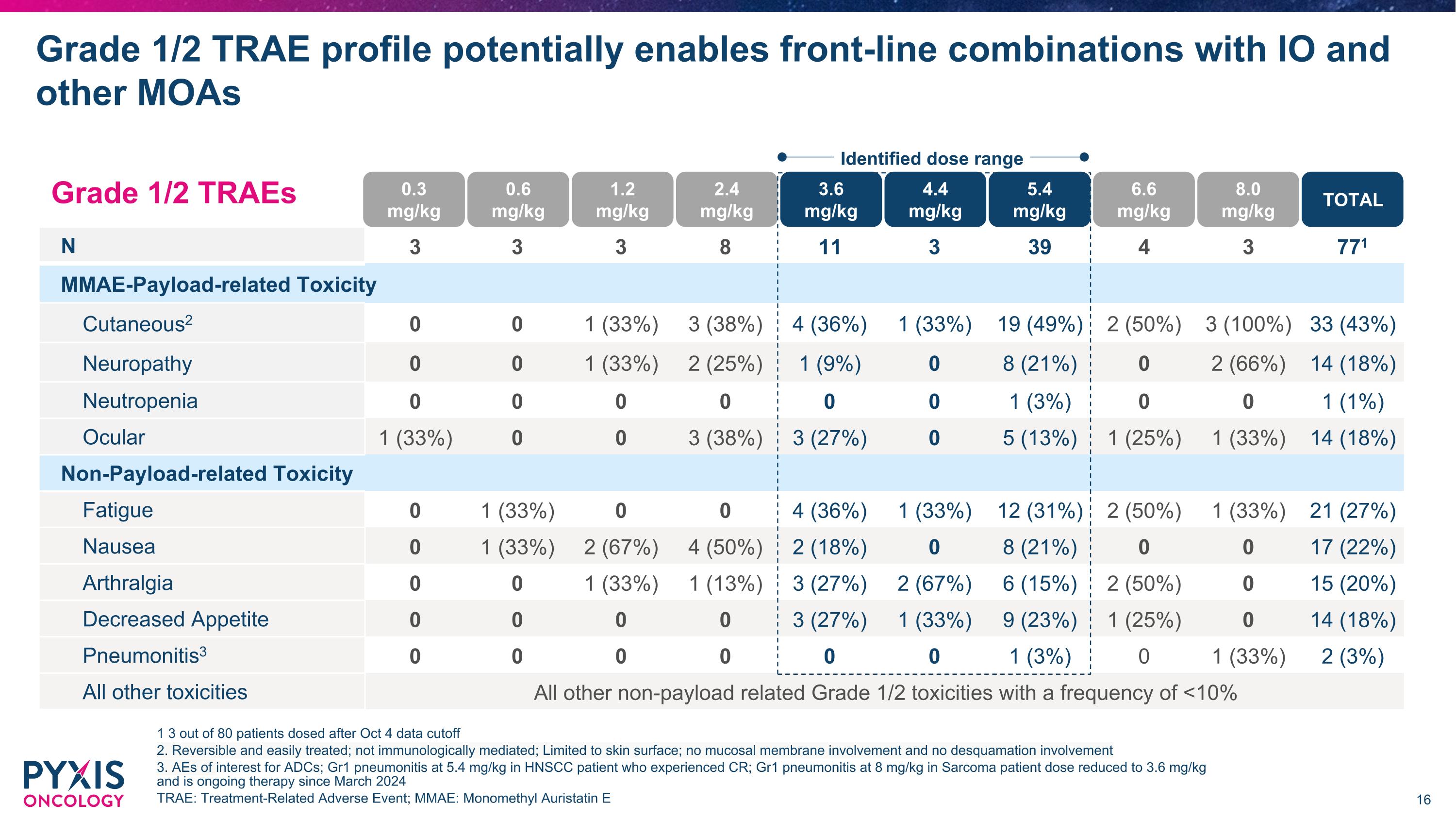
N 3 3 3 8 11 3 39 4 3 771 MMAE-Payload-related Toxicity Cutaneous2 0 0 1 (33%) 3 (38%) 4 (36%) 1 (33%) 19 (49%) 2 (50%) 3 (100%) 33 (43%) Neuropathy 0 0 1 (33%) 2 (25%) 1 (9%) 0 8 (21%) 0 2 (66%) 14 (18%) Neutropenia 0 0 0 0 0 0 1 (3%) 0 0 1 (1%) Ocular 1 (33%) 0 0 3 (38%) 3 (27%) 0 5 (13%) 1 (25%) 1 (33%) 14 (18%) Non-Payload-related Toxicity Fatigue 0 1 (33%) 0 0 4 (36%) 1 (33%) 12 (31%) 2 (50%) 1 (33%) 21 (27%) Nausea 0 1 (33%) 2 (67%) 4 (50%) 2 (18%) 0 8 (21%) 0 0 17 (22%) Arthralgia 0 0 1 (33%) 1 (13%) 3 (27%) 2 (67%) 6 (15%) 2 (50%) 0 15 (20%) Decreased Appetite 0 0 0 0 3 (27%) 1 (33%) 9 (23%) 1 (25%) 0 14 (18%) Pneumonitis3 0 0 0 0 0 0 1 (3%) 0 1 (33%) 2 (3%) All other toxicities All other non-payload related Grade 1/2 toxicities with a frequency of <10% Grade 1/2 TRAE profile potentially enables front-line combinations with IO and other MOAs 1 3 out of 80 patients dosed after Oct 4 data cutoff 2. Reversible and easily treated; not immunologically mediated; Limited to skin surface; no mucosal membrane involvement and no desquamation involvement 3. AEs of interest for ADCs; Gr1 pneumonitis at 5.4 mg/kg in HNSCC patient who experienced CR; Gr1 pneumonitis at 8 mg/kg in Sarcoma patient dose reduced to 3.6 mg/kg and is ongoing therapy since March 2024 TRAE: Treatment-Related Adverse Event; MMAE: Monomethyl Auristatin E 0.3�mg/kg 0.6�mg/kg 1.2�mg/kg 2.4�mg/kg 3.6�mg/kg 4.4�mg/kg 5.4�mg/kg 6.6�mg/kg 8.0�mg/kg TOTAL Identified dose range Grade 1/2 TRAEs
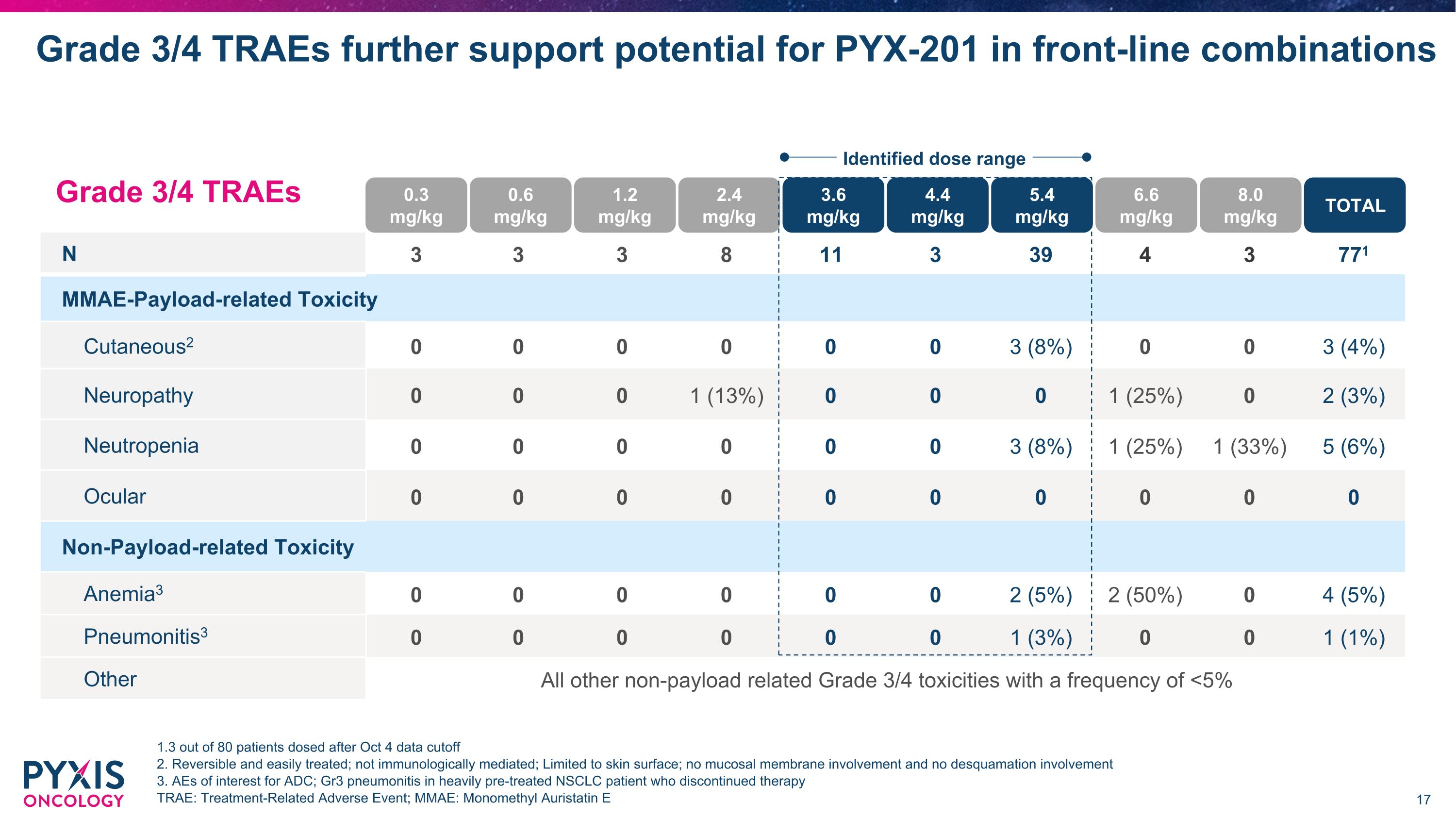
N 3 3 3 8 11 3 39 4 3 771 MMAE-Payload-related Toxicity Cutaneous2 0 0 0 0 0 0 3 (8%) 0 0 3 (4%) Neuropathy 0 0 0 1 (13%) 0 0 0 1 (25%) 0 2 (3%) Neutropenia 0 0 0 0 0 0 3 (8%) 1 (25%) 1 (33%) 5 (6%) Ocular 0 0 0 0 0 0 0 0 0 0 Non-Payload-related Toxicity Anemia3 0 0 0 0 0 0 2 (5%) 2 (50%) 0 4 (5%) Pneumonitis3 0 0 0 0 0 0 1 (3%) 0 0 1 (1%) Other All other non-payload related Grade 3/4 toxicities with a frequency of <5% Grade 3/4 TRAEs further support potential for PYX-201 in front-line combinations 1.3 out of 80 patients dosed after Oct 4 data cutoff 2. Reversible and easily treated; not immunologically mediated; Limited to skin surface; no mucosal membrane involvement and no desquamation involvement 3. AEs of interest for ADC; Gr3 pneumonitis in heavily pre-treated NSCLC patient who discontinued therapy TRAE: Treatment-Related Adverse Event; MMAE: Monomethyl Auristatin E Grade 3/4 TRAEs 0.3�mg/kg 0.6�mg/kg 1.2�mg/kg 2.4�mg/kg 3.6�mg/kg 4.4�mg/kg 5.4�mg/kg 6.6�mg/kg 8.0�mg/kg TOTAL Identified dose range
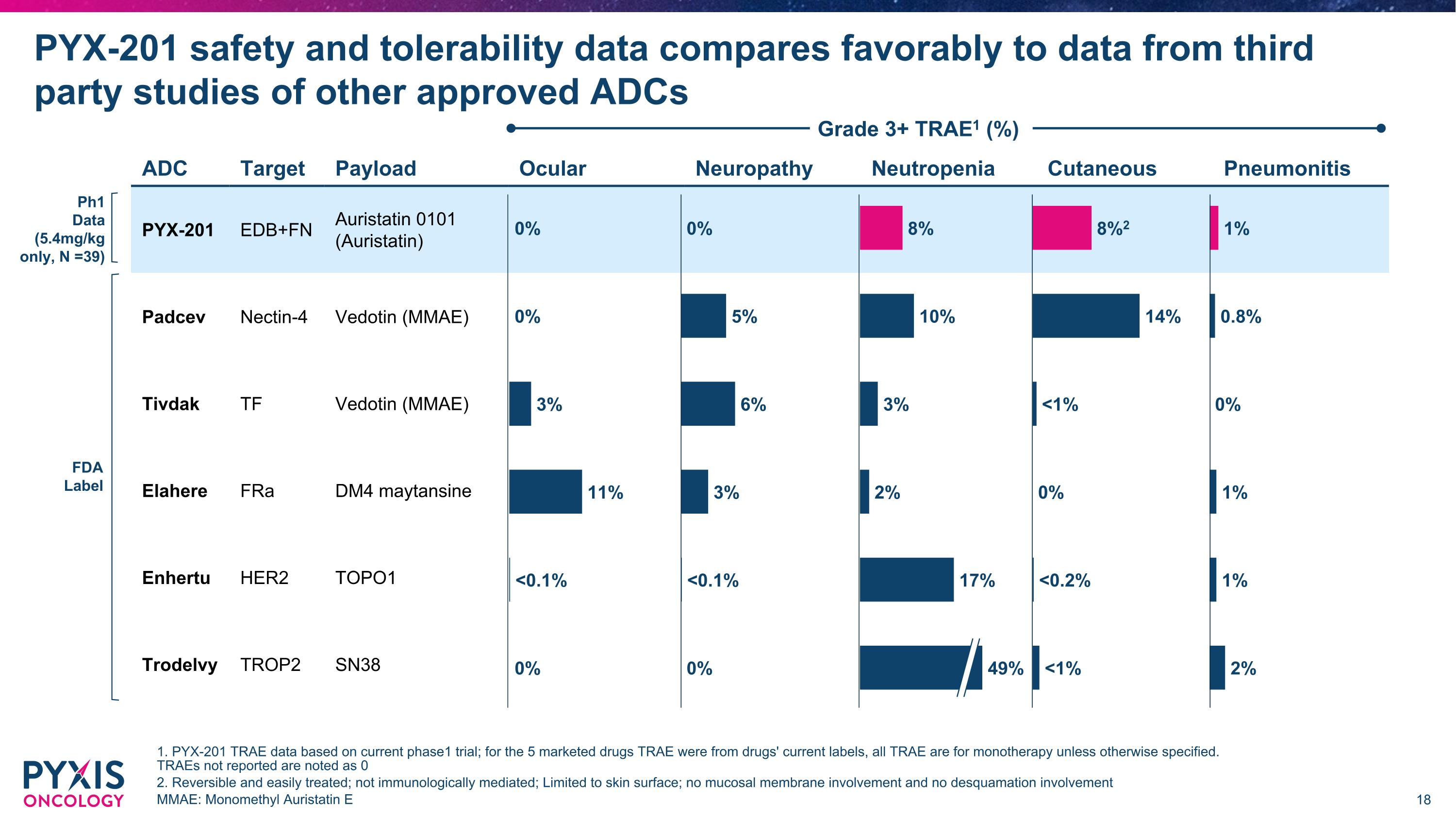
PYX-201 safety and tolerability data compares favorably to data from third party studies of other approved ADCs ADC Target Payload Ocular Neuropathy Neutropenia Cutaneous Pneumonitis PYX-201 EDB+FN Auristatin 0101 (Auristatin) Padcev Nectin-4 Vedotin (MMAE) Tivdak TF Vedotin (MMAE) Elahere FRa DM4 maytansine Enhertu HER2 TOPO1 Trodelvy TROP2 SN38 Grade 3+ TRAE1 (%) 1. PYX-201 TRAE data based on current phase1 trial; for the 5 marketed drugs TRAE were from drugs' current labels, all TRAE are for monotherapy unless otherwise specified. TRAEs not reported are noted as 0 2. Reversible and easily treated; not immunologically mediated; Limited to skin surface; no mucosal membrane involvement and no desquamation involvement MMAE: Monomethyl Auristatin E 8%2 14% <1% 0% <0.2% <1% 0% 5% 6% 3% <0.1% 0% 8% 10% 3% 2% 17% 49% 0% 0% 3% 11% <0.1% 0% 1% 0.8% 0% 1% 1% 2% Ph1 Data (5.4mg/kg only, N =39) FDA Label
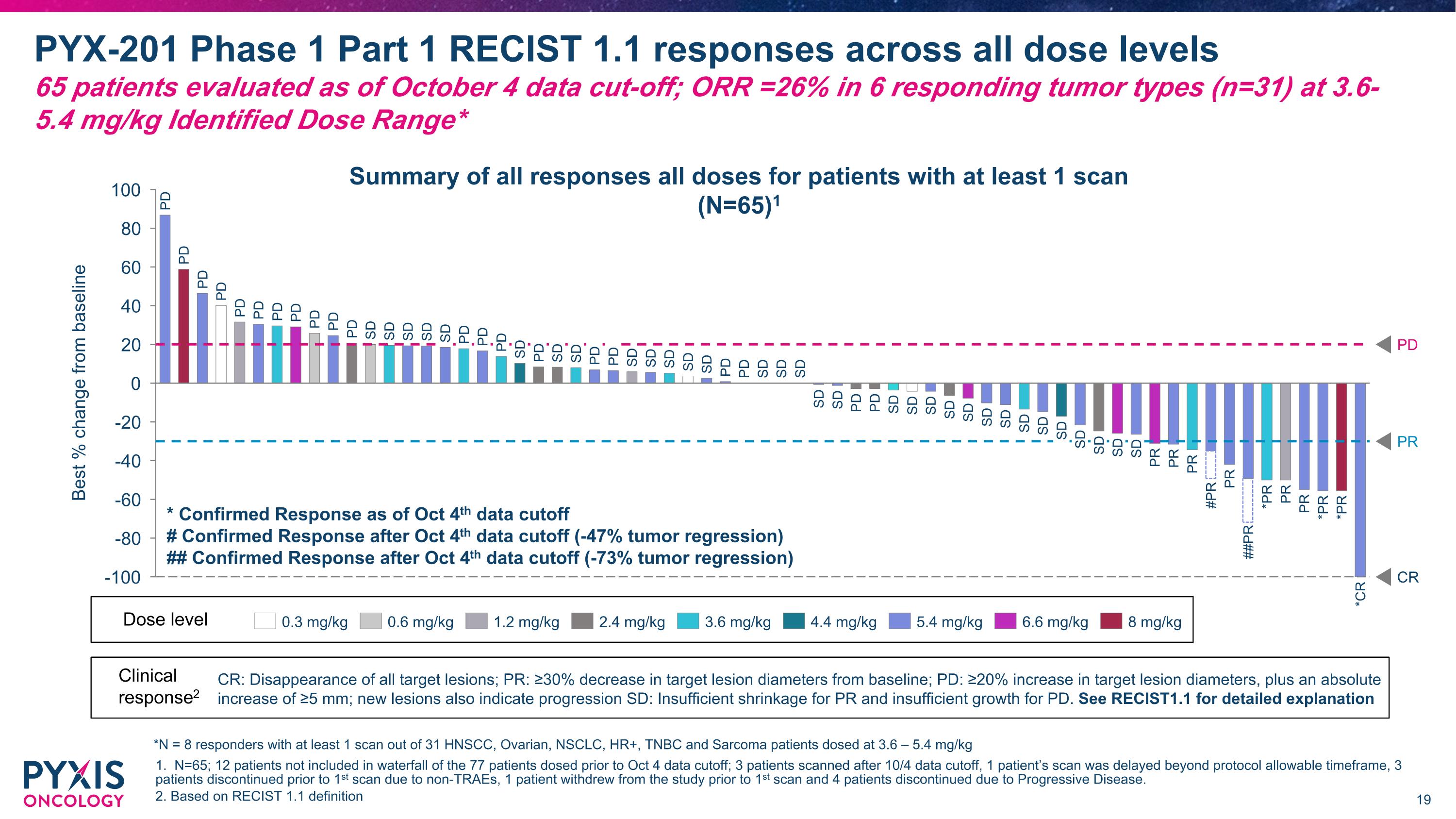
Best % change from baseline PR CR PD PD PD PD PD PD PD PD PD PD PD SD SD SD SD SD PD PD PD SD PD SD SD PD PD SD SD SD SD SD PD PD SD SD SD SD SD PD PD SD SD SD SD PD SD SD SD SD SD SD SD SD SD PR SD PR #PR PR ##PR *PR PR PR *PR *PR *CR PR PYX-201 Phase 1 Part 1 RECIST 1.1 responses across all dose levels�65 patients evaluated as of October 4 data cut-off; ORR =26% in 6 responding tumor types (n=31) at 3.6-5.4 mg/kg Identified Dose Range* 1. N=65; 12 patients not included in waterfall of the 77 patients dosed prior to Oct 4 data cutoff; 3 patients scanned after 10/4 data cutoff, 1 patient’s scan was delayed beyond protocol allowable timeframe, 3 patients discontinued prior to 1st scan due to non-TRAEs, 1 patient withdrew from the study prior to 1st scan and 4 patients discontinued due to Progressive Disease. 2. Based on RECIST 1.1 definition 0.3 mg/kg 0.6 mg/kg 1.2 mg/kg 2.4 mg/kg 3.6 mg/kg 4.4 mg/kg 5.4 mg/kg 6.6 mg/kg 8 mg/kg Dose level Summary of all responses all doses for patients with at least 1 scan (N=65)1 Clinical response2 CR: Disappearance of all target lesions; PR: ≥30% decrease in target lesion diameters from baseline; PD: ≥20% increase in target lesion diameters, plus an absolute increase of ≥5 mm; new lesions also indicate progression SD: Insufficient shrinkage for PR and insufficient growth for PD. See RECIST1.1 for detailed explanation * Confirmed Response as of Oct 4th data cutoff # Confirmed Response after Oct 4th data cutoff (-47% tumor regression) ## Confirmed Response after Oct 4th data cutoff (-73% tumor regression) *N = 8 responders with at least 1 scan out of 31 HNSCC, Ovarian, NSCLC, HR+, TNBC and Sarcoma patients dosed at 3.6 – 5.4 mg/kg
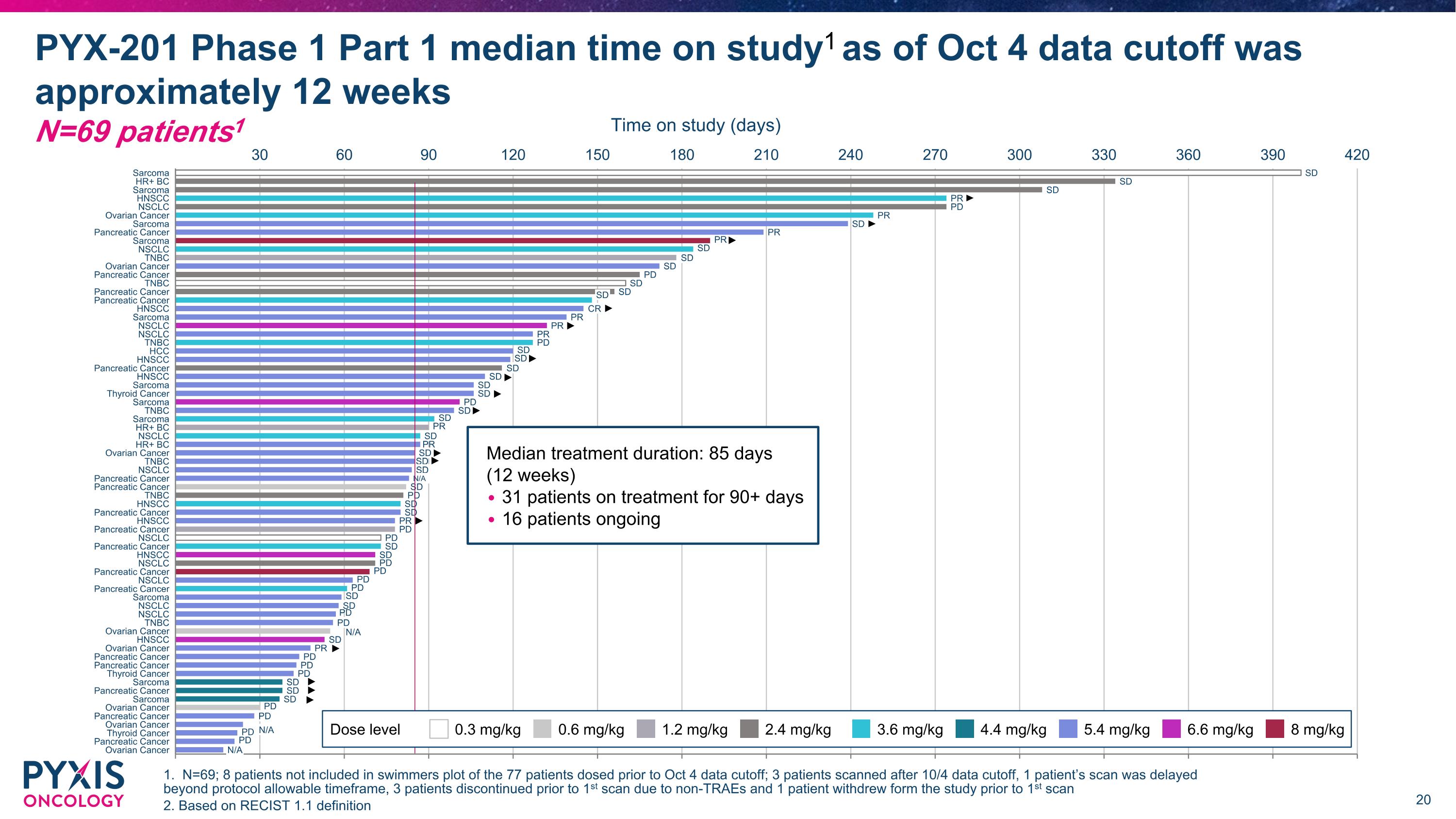
30 60 90 120 150 180 210 240 270 300 330 360 390 420 HR+ BC Sarcoma HNSCC NSCLC Ovarian Cancer Sarcoma Pancreatic Cancer Sarcoma NSCLC TNBC Ovarian Cancer Pancreatic Cancer TNBC Pancreatic Cancer Pancreatic Cancer HNSCC Sarcoma NSCLC NSCLC TNBC HCC HNSCC Pancreatic Cancer HNSCC Sarcoma Thyroid Cancer Sarcoma TNBC Sarcoma HR+ BC NSCLC HR+ BC Ovarian Cancer TNBC NSCLC Pancreatic Cancer Pancreatic Cancer TNBC HNSCC Pancreatic Cancer HNSCC Pancreatic Cancer NSCLC Pancreatic Cancer HNSCC NSCLC Pancreatic Cancer NSCLC Pancreatic Cancer Sarcoma NSCLC NSCLC TNBC Ovarian Cancer HNSCC Ovarian Cancer Pancreatic Cancer Pancreatic Cancer Thyroid Cancer Sarcoma Pancreatic Cancer Sarcoma Ovarian Cancer Pancreatic Cancer Ovarian Cancer Thyroid Cancer Pancreatic Cancer Ovarian Cancer SD SD SD PR PD PR SD PR PR SD SD SD PD SD SD SD CR PR PR PR PD SD SD SD SD SD SD PD SD SD PR Sarcoma SD SD SD N/A SD PD SD SD PR PD PD SD SD PD PD PD PD SD SD PD PD N/A SD PR PD PD PD SD SD SD PD PD N/A PD PD N/A SD 1. N=69; 8 patients not included in swimmers plot of the 77 patients dosed prior to Oct 4 data cutoff; 3 patients scanned after 10/4 data cutoff, 1 patient’s scan was delayed beyond protocol allowable timeframe, 3 patients discontinued prior to 1st scan due to non-TRAEs and 1 patient withdrew form the study prior to 1st scan 2. Based on RECIST 1.1 definition PYX-201 Phase 1 Part 1 median time on study1 as of Oct 4 data cutoff was approximately 12 weeks�N=69 patients1 Time on study (days) 0.3 mg/kg 0.6 mg/kg 1.2 mg/kg 2.4 mg/kg 3.6 mg/kg 4.4 mg/kg 5.4 mg/kg 6.6 mg/kg 8 mg/kg Dose level PR Median treatment duration: 85 days (12 weeks) 31 patients on treatment for 90+ days 16 patients ongoing
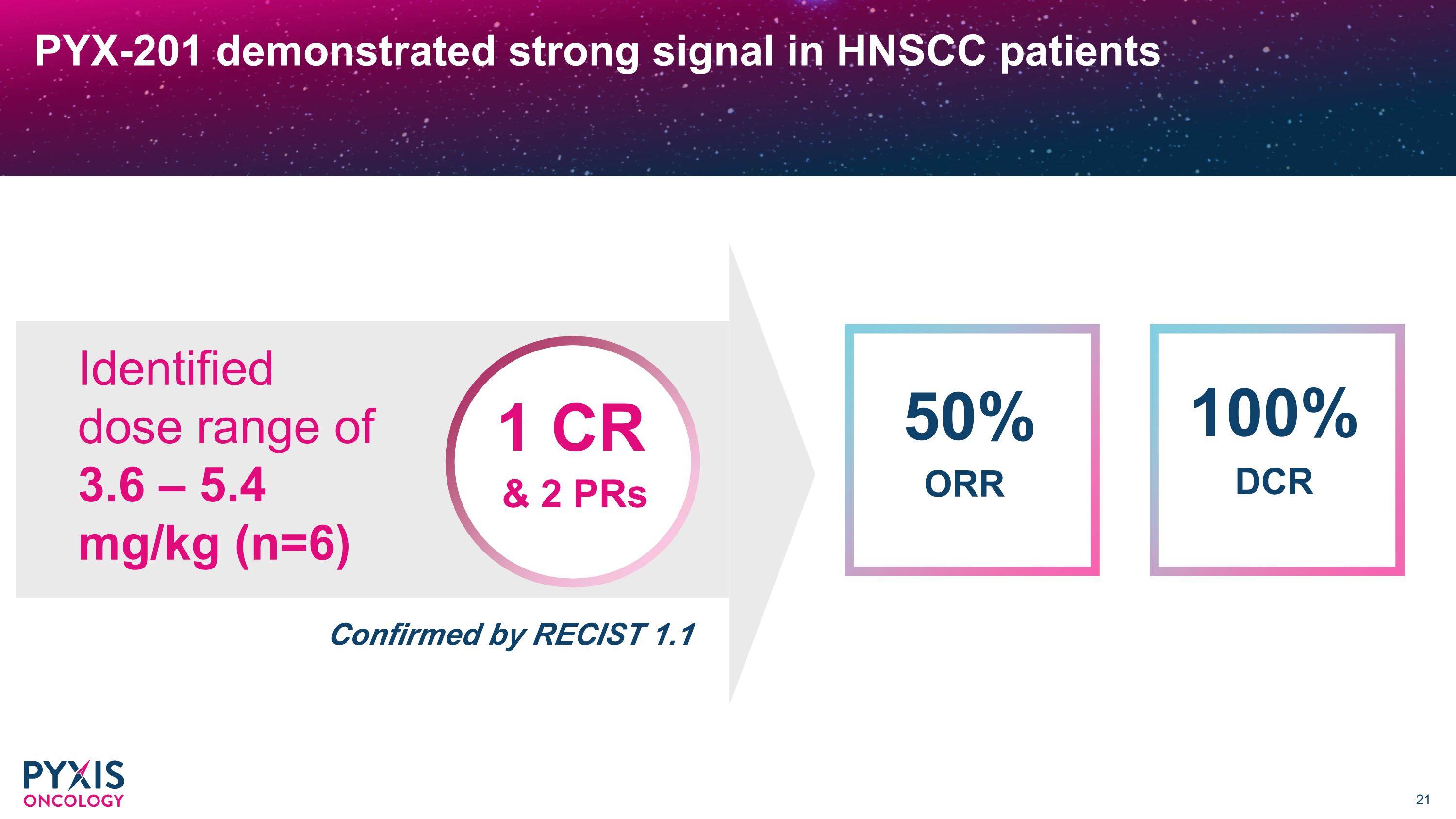
PYX-201 demonstrated strong signal in HNSCC patients Identified dose range of 3.6 – 5.4 mg/kg (n=6) 100% DCR Confirmed by RECIST 1.1 ORR 50% & 2 PRs 1 CR
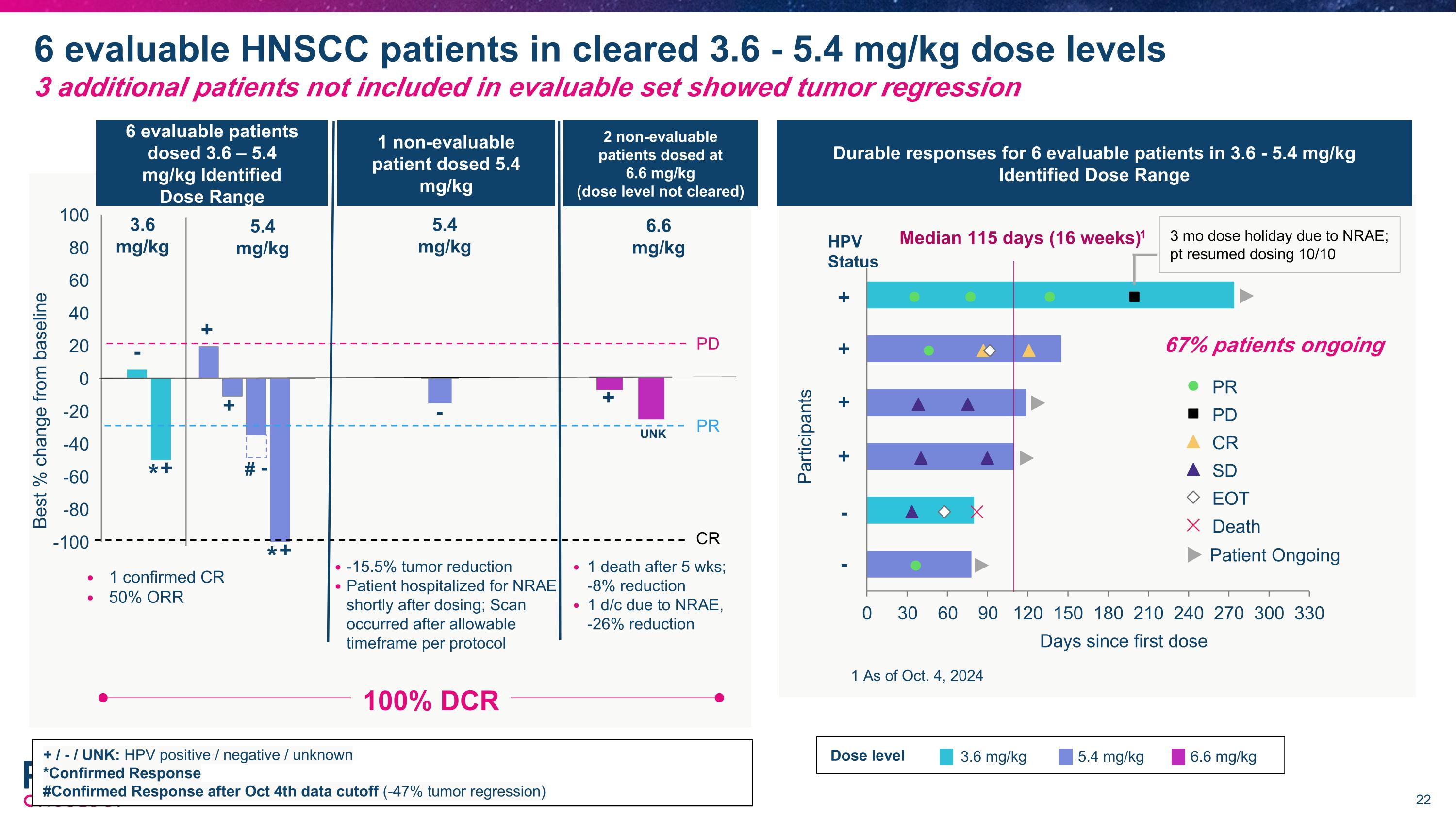
1 confirmed CR 50% ORR Participants Days since first dose PR PD CR SD EOT Death Median 115 days (16 weeks)1 Durable responses for 6 evaluable patients in 3.6 - 5.4 mg/kg Identified Dose Range Patient Ongoing -100 -80 -60 -40 -20 0 20 40 60 80 100 3.6 mg/kg 5.4 mg/kg + / - / UNK: HPV positive / negative / unknown *Confirmed Response #Confirmed Response after Oct 4th data cutoff (-47% tumor regression) # Best % change from baseline PD PR CR * + + + * + 67% patients ongoing 6.6 mg/kg + 6 evaluable patients dosed 3.6 – 5.4 mg/kg Identified Dose Range 1 non-evaluable patient dosed 5.4 mg/kg 1 As of Oct. 4, 2024 2 non-evaluable patients dosed at 6.6 mg/kg (dose level not cleared) -15.5% tumor reduction Patient hospitalized for NRAE shortly after dosing; Scan occurred after allowable timeframe per protocol 1 death after 5 wks; -8% reduction 1 d/c due to NRAE, -26% reduction 5.4 mg/kg 3.6 mg/kg 5.4 mg/kg Dose level 6.6 mg/kg 6 evaluable HNSCC patients in cleared 3.6 - 5.4 mg/kg dose levels�3 additional patients not included in evaluable set showed tumor regression - - UNK - 3 mo dose holiday due to NRAE; pt resumed dosing 10/10 - + HPV Status + - + + 100% DCR
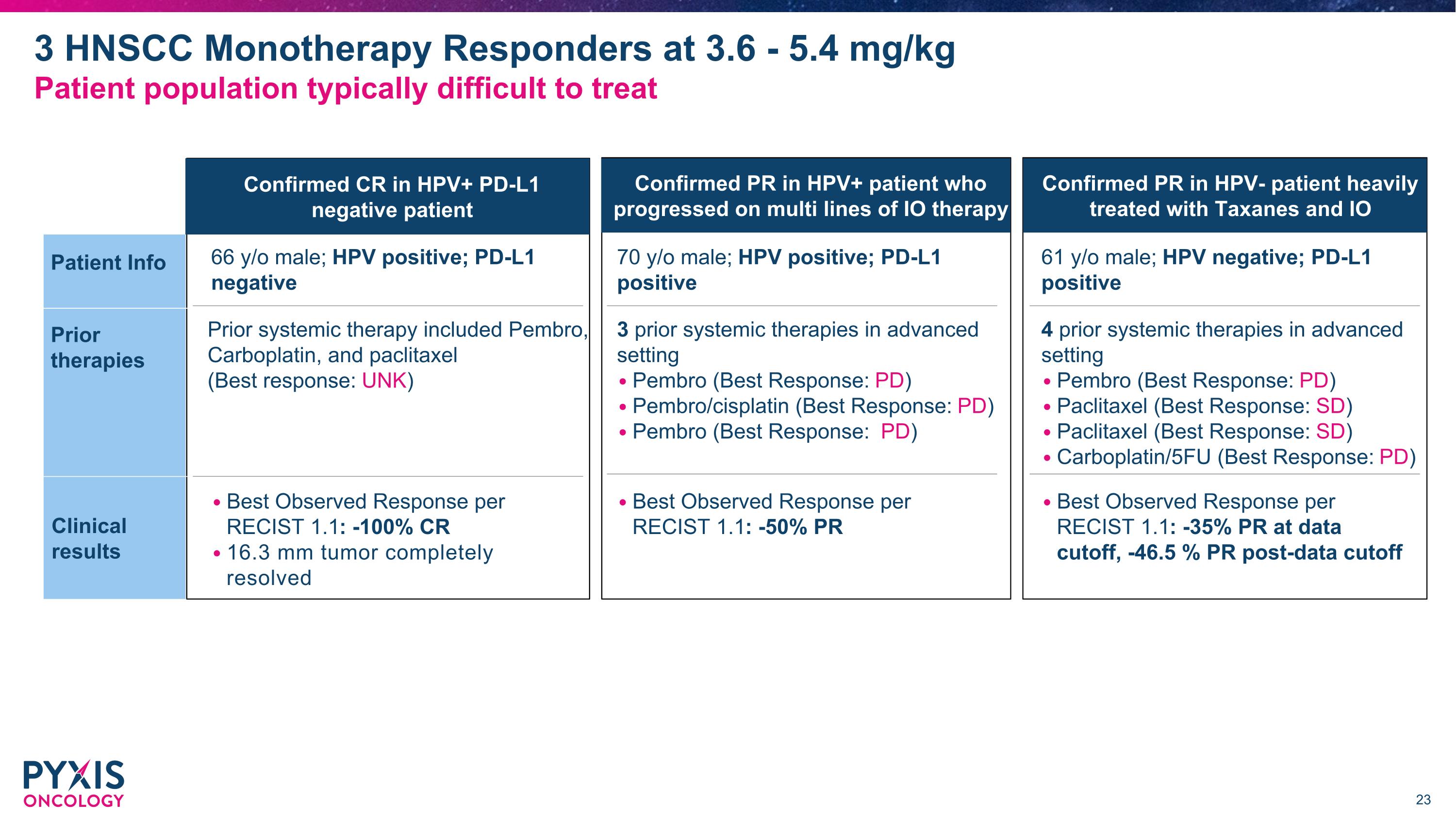
Confirmed CR in HPV+ PD-L1 negative patient Confirmed PR in HPV- patient heavily treated with Taxanes and IO Confirmed PR in HPV+ patient who progressed on multi lines of IO therapy Best Observed Response per RECIST 1.1: -100% CR 16.3 mm tumor completely resolved 66 y/o male; HPV positive; PD-L1 negative Best Observed Response per RECIST 1.1: -50% PR 70 y/o male; HPV positive; PD-L1 positive 61 y/o male; HPV negative; PD-L1 positive Patient Info Prior �therapies Clinical �results Prior systemic therapy included Pembro, Carboplatin, and paclitaxel (Best response: UNK) 3 prior systemic therapies in advanced setting Pembro (Best Response: PD) Pembro/cisplatin (Best Response: PD) Pembro (Best Response: PD) 4 prior systemic therapies in advanced setting Pembro (Best Response: PD) Paclitaxel (Best Response: SD) Paclitaxel (Best Response: SD) Carboplatin/5FU (Best Response: PD) 3 HNSCC Monotherapy Responders at 3.6 - 5.4 mg/kg�Patient population typically difficult to treat Best Observed Response per RECIST 1.1: -35% PR at data cutoff, -46.5 % PR post-data cutoff
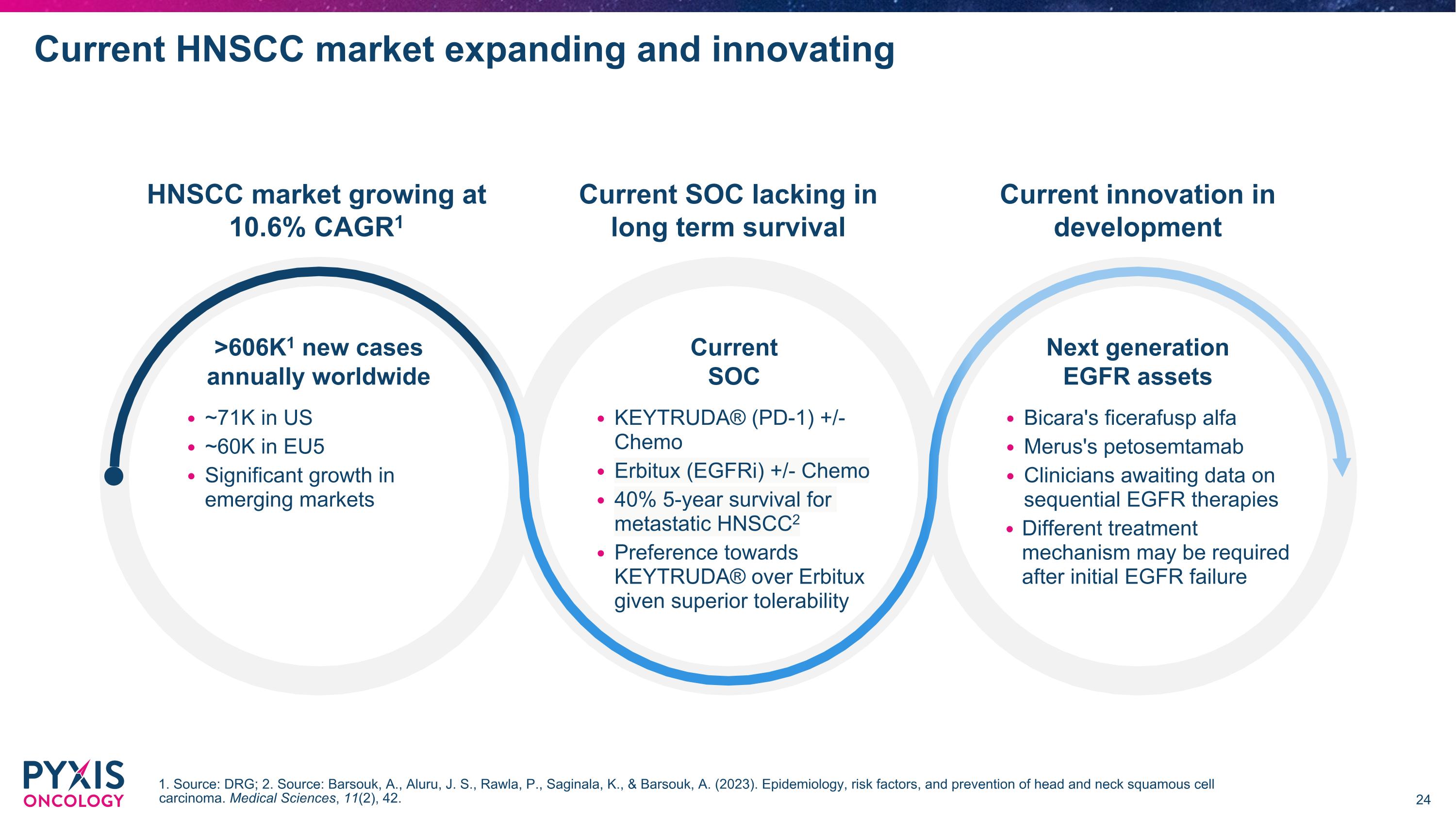
Current HNSCC market expanding and innovating HNSCC market growing at 10.6% CAGR1 >606K1 new cases annually worldwide Current�SOC Current SOC lacking in long term survival Current innovation in development Next generation�EGFR assets 1. Source: DRG; 2. Source: Barsouk, A., Aluru, J. S., Rawla, P., Saginala, K., & Barsouk, A. (2023). Epidemiology, risk factors, and prevention of head and neck squamous cell carcinoma. Medical Sciences, 11(2), 42. ~71K in US ~60K in EU5 Significant growth in emerging markets KEYTRUDA® (PD-1) +/- Chemo Erbitux (EGFRi) +/- Chemo 40% 5-year survival for metastatic HNSCC2 Preference towards KEYTRUDA® over Erbitux given superior tolerability Bicara's ficerafusp alfa Merus's petosemtamab Clinicians awaiting data on sequential EGFR therapies Different treatment mechanism may be required after initial EGFR failure
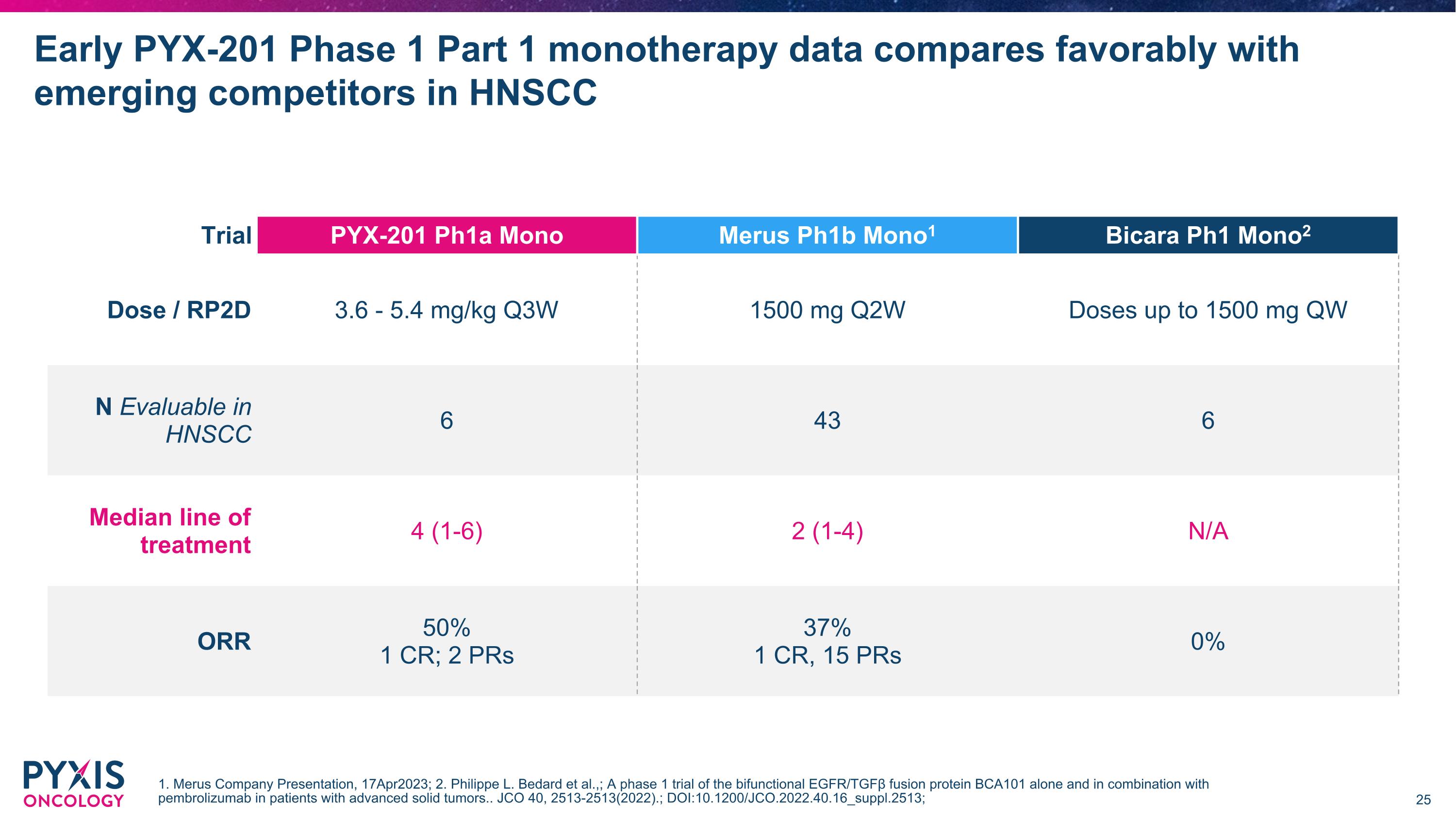
Early PYX-201 Phase 1 Part 1 monotherapy data compares favorably with emerging competitors in HNSCC 1. Merus Company Presentation, 17Apr2023; 2. Philippe L. Bedard et al.,; A phase 1 trial of the bifunctional EGFR/TGFβ fusion protein BCA101 alone and in combination with pembrolizumab in patients with advanced solid tumors.. JCO 40, 2513-2513(2022).; DOI:10.1200/JCO.2022.40.16_suppl.2513; Trial PYX-201 Ph1a Mono Merus Ph1b Mono1 Bicara Ph1 Mono2 Dose / RP2D 3.6 - 5.4 mg/kg Q3W 1500 mg Q2W Doses up to 1500 mg QW N Evaluable in HNSCC 6 43 6 Median line of treatment 4 (1-6) 2 (1-4) N/A ORR 50% 1 CR; 2 PRs 37% 1 CR, 15 PRs 0%
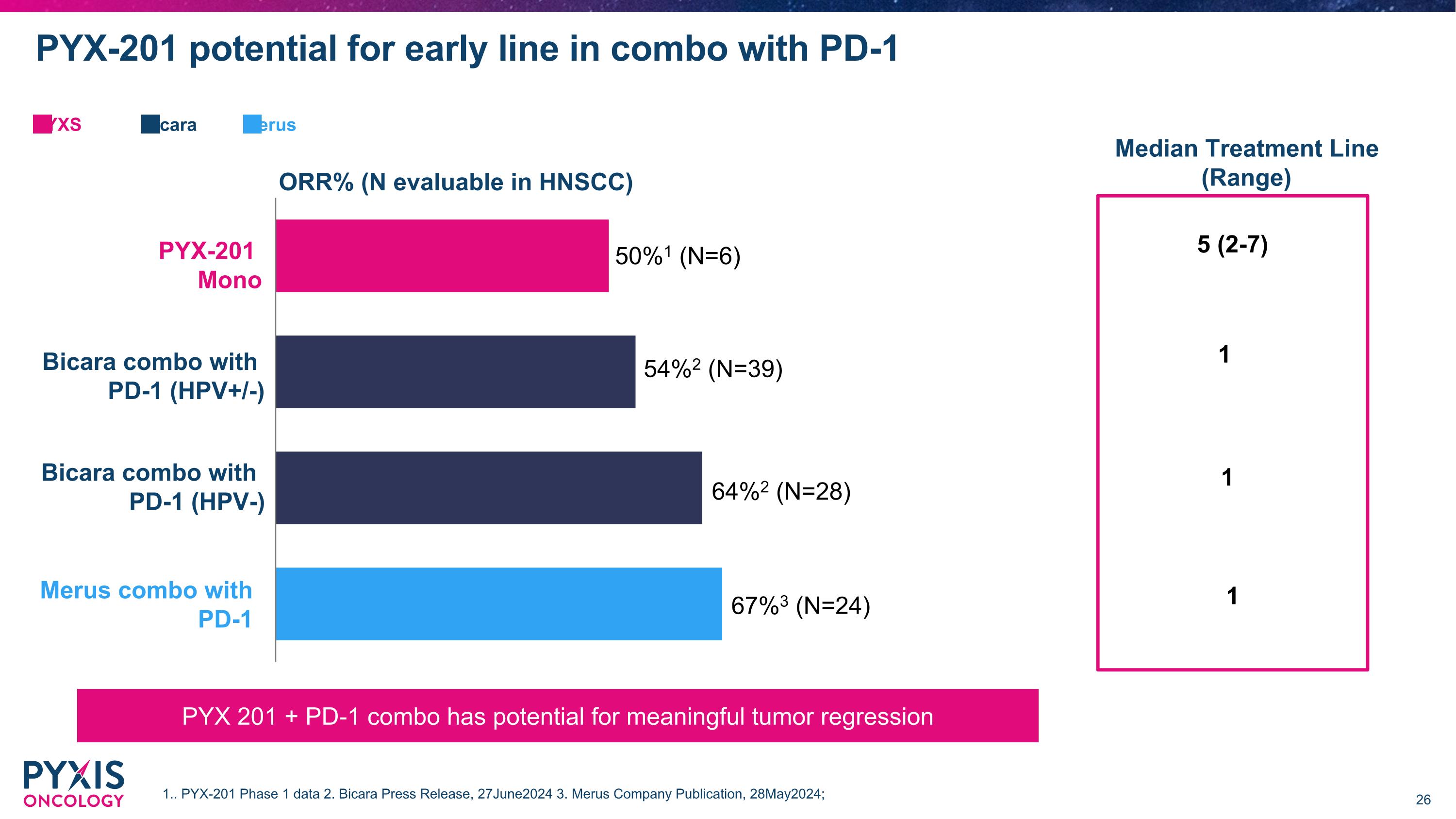
PYX-201 potential for early line in combo with PD-1 PYX-201 Mono Merus combo with PD-1 Bicara combo with PD-1 (HPV-) ORR% (N evaluable in HNSCC) 50%1 (N=6) 67%3 (N=24) 64%2 (N=28) Bicara combo with PD-1 (HPV+/-) Bicara Merus PYXS 1.. PYX-201 Phase 1 data 2. Bicara Press Release, 27June2024 3. Merus Company Publication, 28May2024; Median Treatment Line (Range) 5 (2-7) 1 1 1 PYX 201 + PD-1 combo has potential for meaningful tumor regression 54%2 (N=39)
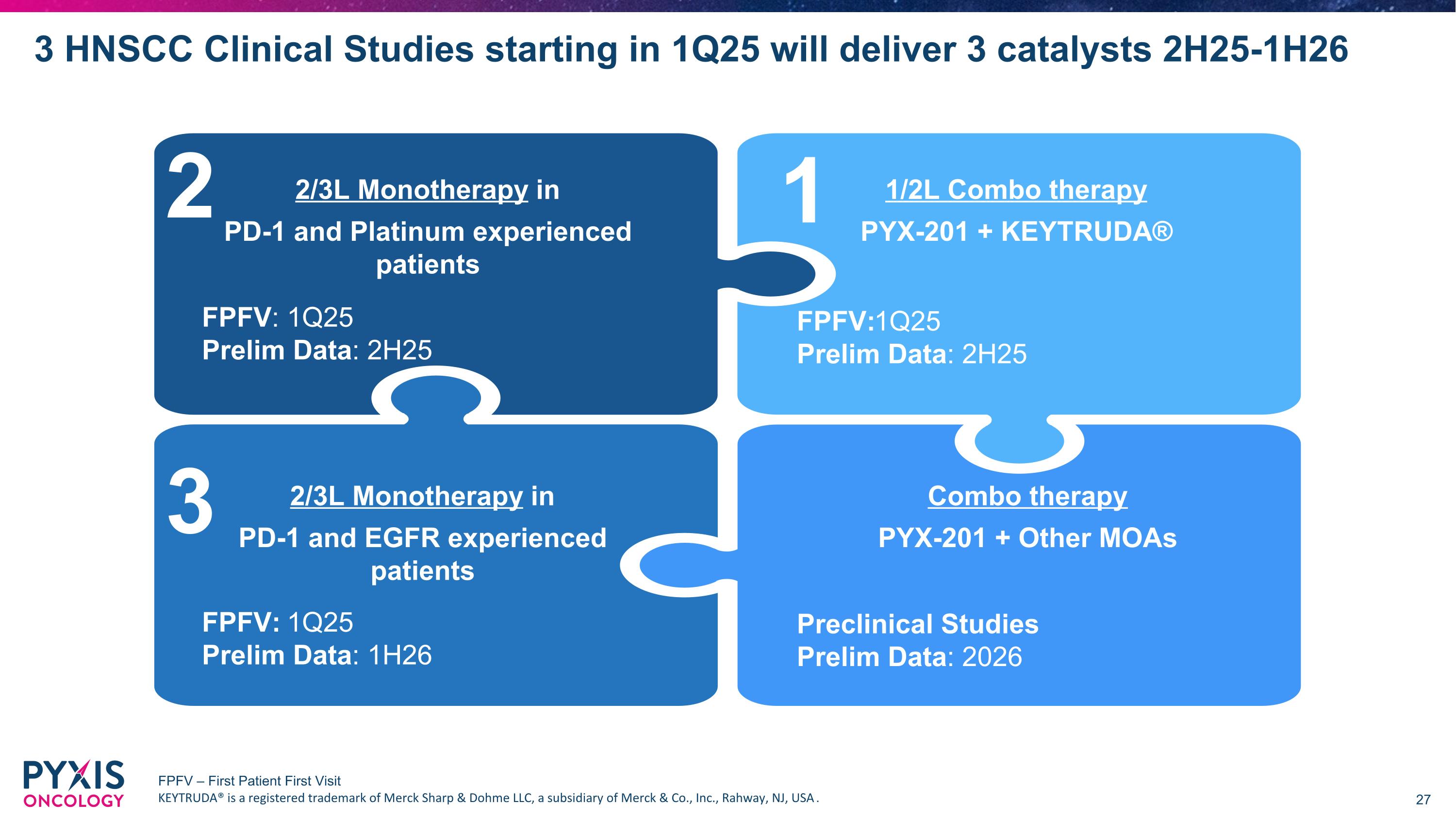
3 HNSCC Clinical Studies starting in 1Q25 will deliver 3 catalysts 2H25-1H26 2/3L Monotherapy in PD-1 and EGFR experienced patients Potential Opportunity: Limited next set of options for these patients beyond chemo 1/2L Combo therapy PYX-201 + KEYTRUDA® Potential Opportunity: Improved tolerability and potentiation of KEYTRUDA® impact 2/3L Monotherapy in PD-1 and Platinum experienced patients Potential Opportunity: Combo may not be tolerated for long periods of time Combo therapy PYX-201 + Other MOAs (Preclinical studies) Potential Opportunity: Extracellular MOA could enhance current and emerging therapies (e.g., EGFR, VEGF, Platinum) 2/3L Monotherapy in PD-1 and EGFR experienced patients 1/2L Combo therapy PYX-201 + KEYTRUDA® 2/3L Monotherapy in PD-1 and Platinum experienced patients Combo therapy PYX-201 + Other MOAs 2 3 1 FPFV: 1Q25 Prelim Data: 2H25 FPFV: 1Q25 Prelim Data: 1H26 Preclinical Studies Prelim Data: 2026 FPFV:1Q25 Prelim Data: 2H25 FPFV – First Patient First Visit KEYTRUDA® is a registered trademark of Merck Sharp & Dohme LLC, a subsidiary of Merck & Co., Inc., Rahway, NJ, USA.
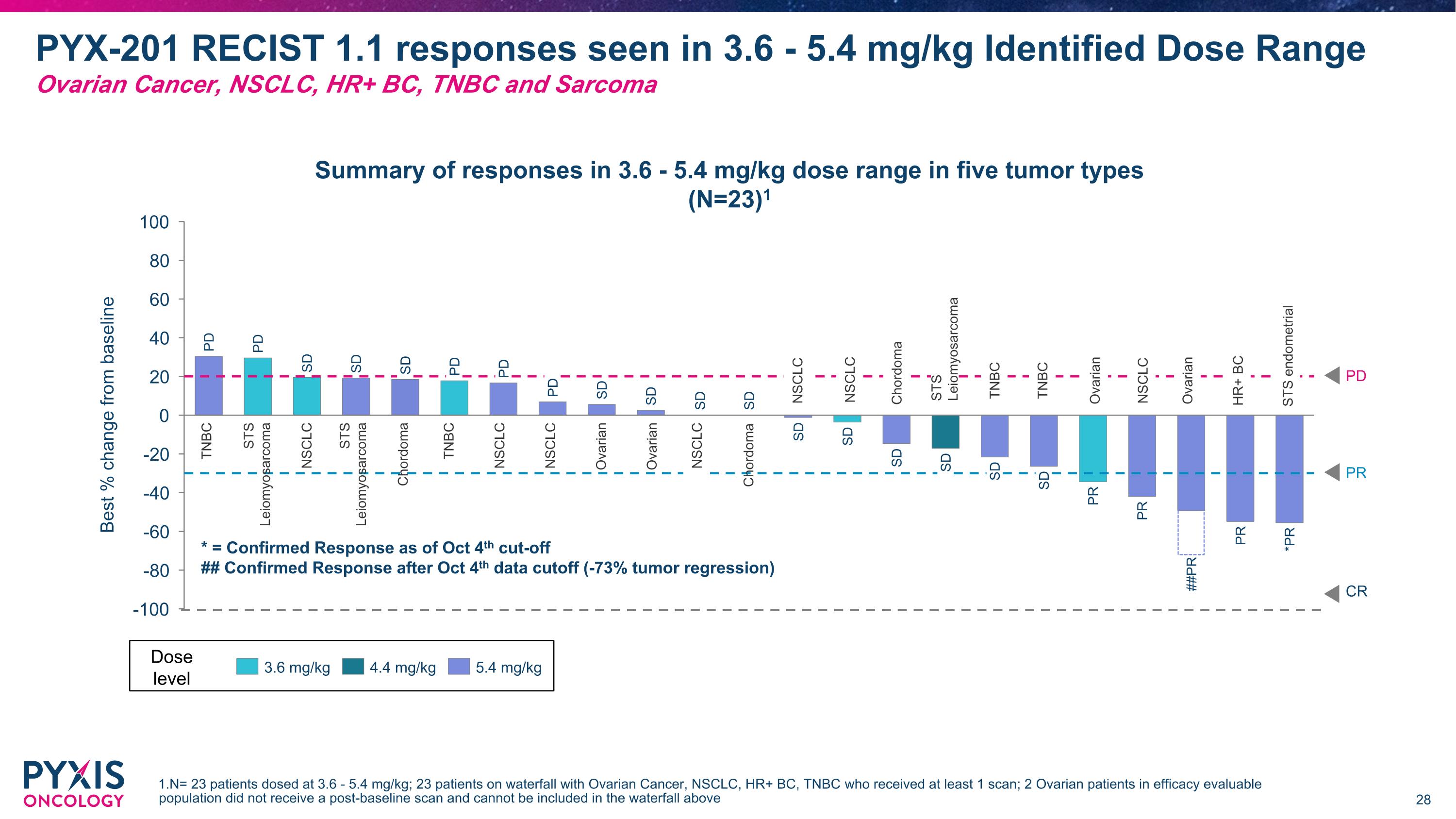
PD PD SD SD SD PD PD Best % change from baseline SD SD SD SD SD SD SD SD SD SD PR PR ##PR PR *PR PD PYX-201 RECIST 1.1 responses seen in 3.6 - 5.4 mg/kg Identified Dose Range�Ovarian Cancer, NSCLC, HR+ BC, TNBC and Sarcoma * = Confirmed Response as of Oct 4th cut-off ## Confirmed Response after Oct 4th data cutoff (-73% tumor regression) 3.6 mg/kg 4.4 mg/kg 5.4 mg/kg Dose level Summary of responses in 3.6 - 5.4 mg/kg dose range in five tumor types (N=23)1 CR PD PR TNBC STS Leiomyosarcoma NSCLC Chordoma TNBC NSCLC NSCLC Ovarian Ovarian Chordoma NSCLC NSCLC TNBC TNBC NSCLC Ovarian NSCLC Ovarian HR+ BC STS endometrial Chordoma STS Leiomyosarcoma STS Leiomyosarcoma 1.N= 23 patients dosed at 3.6 - 5.4 mg/kg; 23 patients on waterfall with Ovarian Cancer, NSCLC, HR+ BC, TNBC who received at least 1 scan; 2 Ovarian patients in efficacy evaluable population did not receive a post-baseline scan and cannot be included in the waterfall above
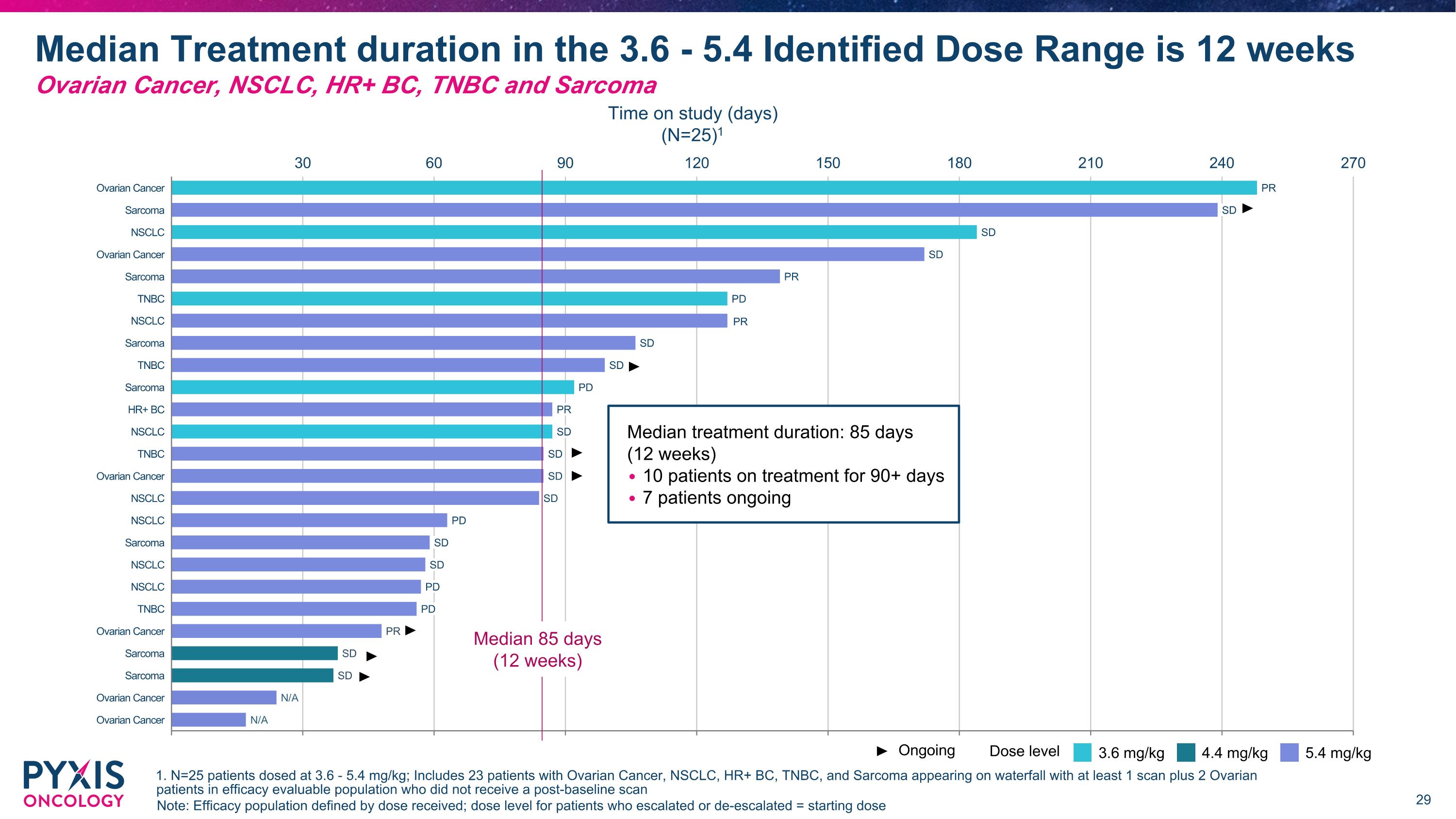
30 60 90 120 150 180 210 240 270 Sarcoma NSCLC Ovarian Cancer Sarcoma TNBC NSCLC Sarcoma TNBC Sarcoma HR+ BC NSCLC TNBC Ovarian Cancer NSCLC NSCLC Sarcoma NSCLC NSCLC TNBC Ovarian Cancer Sarcoma Sarcoma Ovarian Cancer Ovarian Cancer PR SD SD SD PR PD SD SD PD PR Ovarian Cancer SD SD SD PD SD SD SD PD PR SD SD N/A N/A PD Note: Efficacy population defined by dose received; dose level for patients who escalated or de-escalated = starting dose Median Treatment duration in the 3.6 - 5.4 Identified Dose Range is 12 weeks�Ovarian Cancer, NSCLC, HR+ BC, TNBC and Sarcoma 3.6 mg/kg 4.4 mg/kg 5.4 mg/kg Dose level Time on study (days) (N=25)1 Ongoing PR Median 85 days (12 weeks) Median treatment duration: 85 days (12 weeks) 10 patients on treatment for 90+ days 7 patients ongoing 1. N=25 patients dosed at 3.6 - 5.4 mg/kg; Includes 23 patients with Ovarian Cancer, NSCLC, HR+ BC, TNBC, and Sarcoma appearing on waterfall with at least 1 scan plus 2 Ovarian patients in efficacy evaluable population who did not receive a post-baseline scan
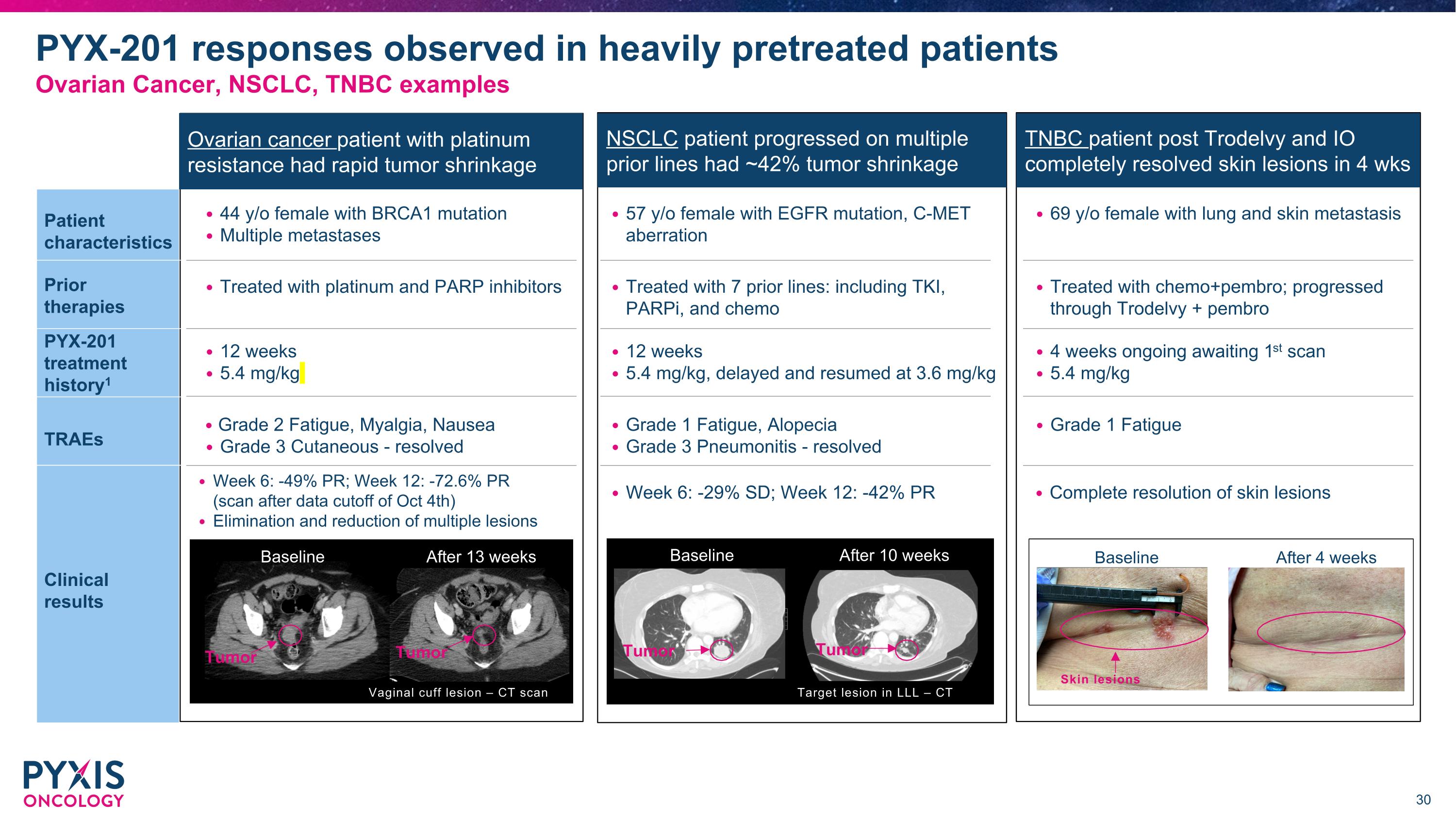
Ovarian cancer patient with platinum �resistance had rapid tumor shrinkage TNBC patient post Trodelvy and IO �completely resolved skin lesions in 4 wks NSCLC patient progressed on multiple prior lines had ~42% tumor shrinkage Week 6: -49% PR; Week 12: -72.6% PR �(scan after data cutoff of Oct 4th) Elimination and reduction of multiple lesions 44 y/o female with BRCA1 mutation Multiple metastases 12 weeks 5.4 mg/kg Grade 2 Fatigue, Myalgia, Nausea Grade 3 Cutaneous - resolved Week 6: -29% SD; Week 12: -42% PR 57 y/o female with EGFR mutation, C-MET aberration 12 weeks 5.4 mg/kg, delayed and resumed at 3.6 mg/kg Grade 1 Fatigue, Alopecia Grade 3 Pneumonitis - resolved Complete resolution of skin lesions 69 y/o female with lung and skin metastasis 4 weeks ongoing awaiting 1st scan 5.4 mg/kg Grade 1 Fatigue Baseline After 13 weeks Vaginal cuff lesion – CT scan Tumor Tumor Baseline After 4 weeks Skin lesions Target lesion in LLL – CT scan Baseline After 10 weeks Tumor Tumor Patient characteristics Prior �therapies PYX-201 treatment �history1 TRAEs Clinical �results Treated with platinum and PARP inhibitors Treated with 7 prior lines: including TKI, PARPi, and chemo Treated with chemo+pembro; progressed through Trodelvy + pembro PYX-201 responses observed in heavily pretreated patients �Ovarian Cancer, NSCLC, TNBC examples
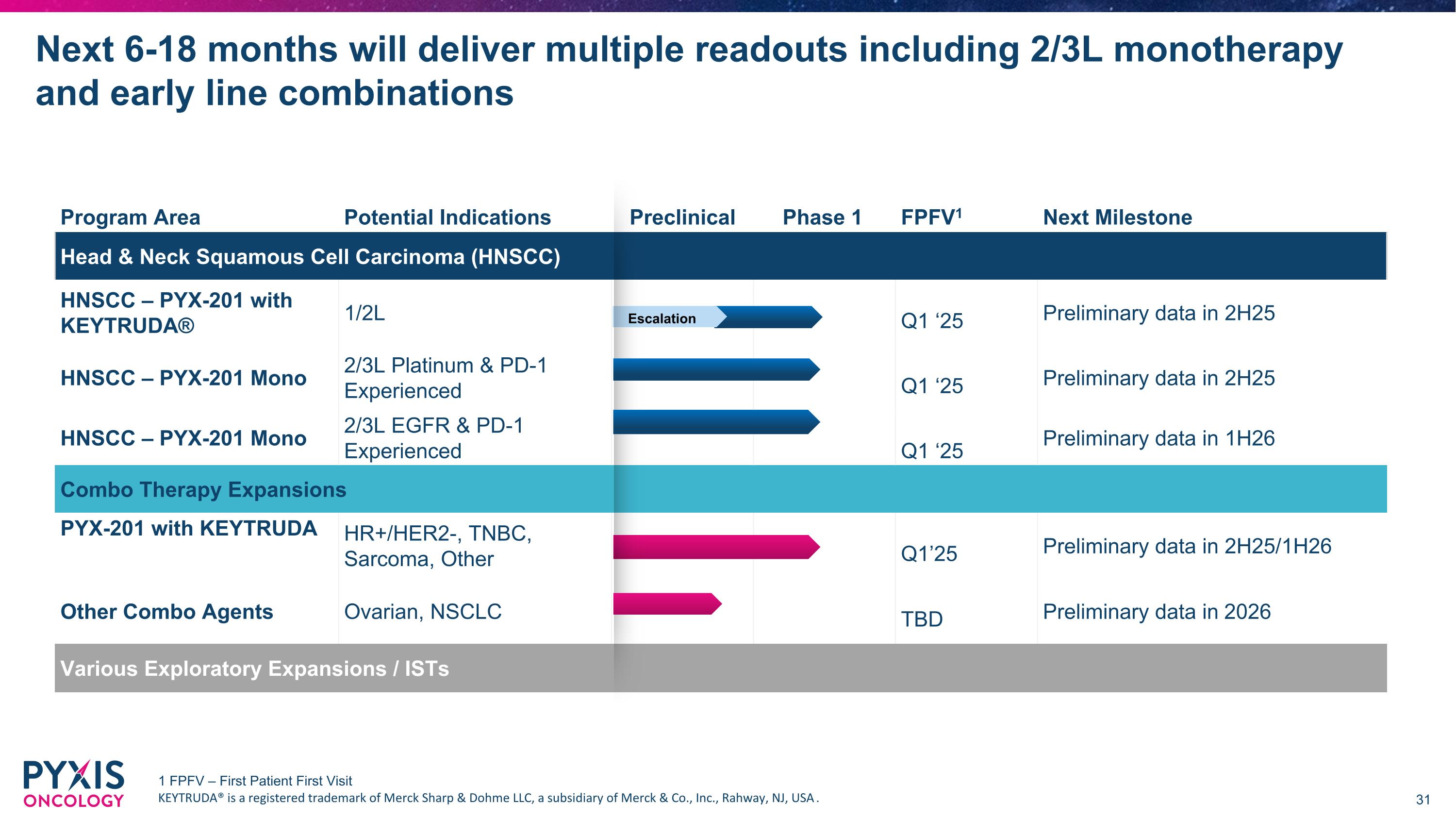
Program Area Potential Indications Preclinical Phase 1 FPFV1 Next Milestone Head & Neck Squamous Cell Carcinoma (HNSCC) HNSCC – PYX-201 with KEYTRUDA® 1/2L Q1 ‘25 Preliminary data in 2H25 HNSCC – PYX-201 Mono 2/3L Platinum & PD-1 Experienced Q1 ‘25 Preliminary data in 2H25 HNSCC – PYX-201 Mono 2/3L EGFR & PD-1 �Experienced Q1 ‘25 Preliminary data in 1H26 Combo Therapy Expansions PYX-201 with KEYTRUDA HR+/HER2-, TNBC, Sarcoma, Other Q1’25 Preliminary data in 2H25/1H26 Other Combo Agents Ovarian, NSCLC TBD Preliminary data in 2026 Various Exploratory Expansions / ISTs Next 6-18 months will deliver multiple readouts including 2/3L monotherapy and early line combinations Escalation 1 FPFV – First Patient First Visit KEYTRUDA® is a registered trademark of Merck Sharp & Dohme LLC, a subsidiary of Merck & Co., Inc., Rahway, NJ, USA.
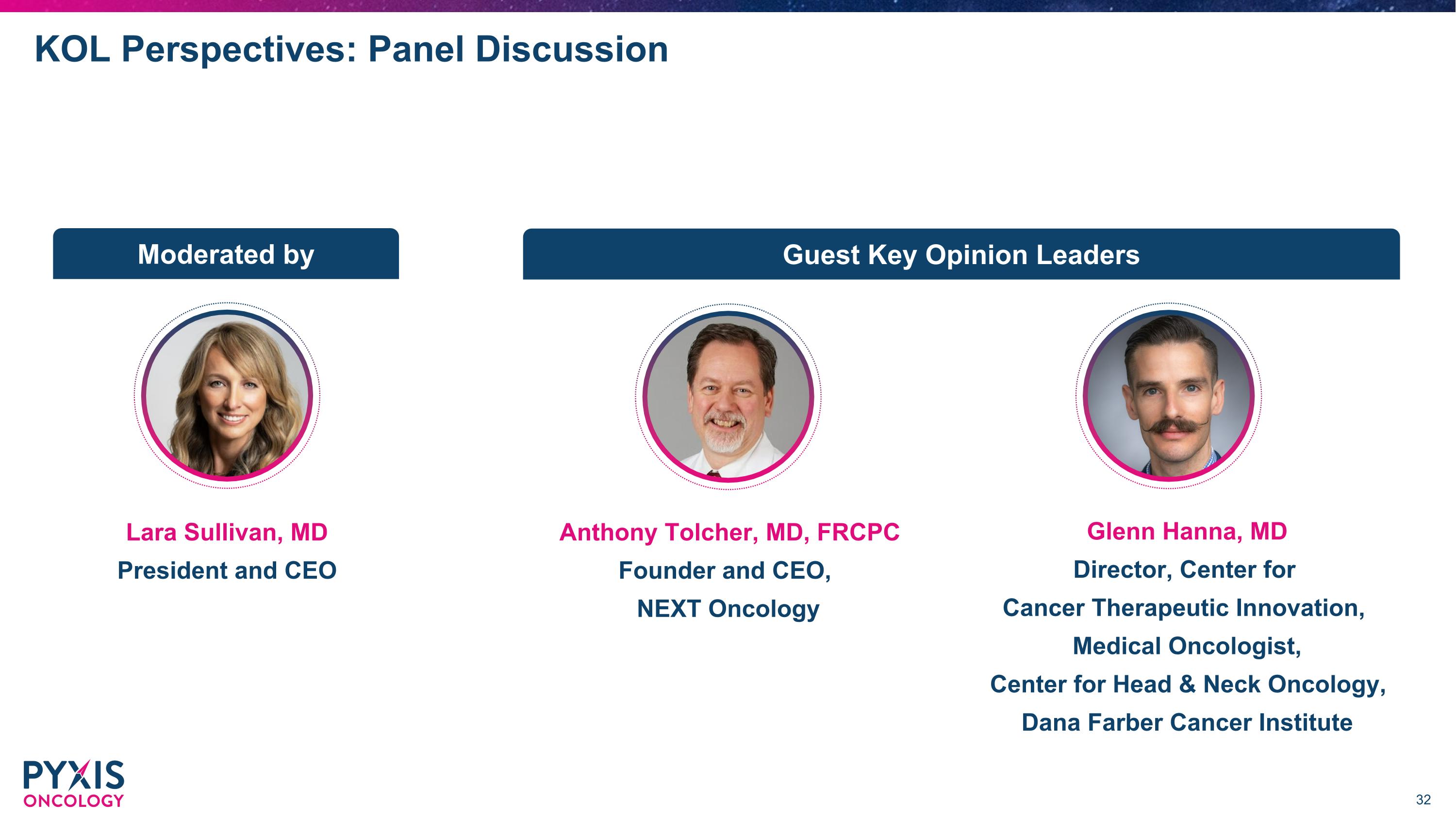
KOL Perspectives: Panel Discussion Lara Sullivan, MD President and CEO Moderated by Glenn Hanna, MD Director, Center for Cancer Therapeutic Innovation, Medical Oncologist, Center for Head & Neck Oncology, Dana Farber Cancer Institute Guest Key Opinion Leaders Anthony Tolcher, MD, FRCPC Founder and CEO, NEXT Oncology
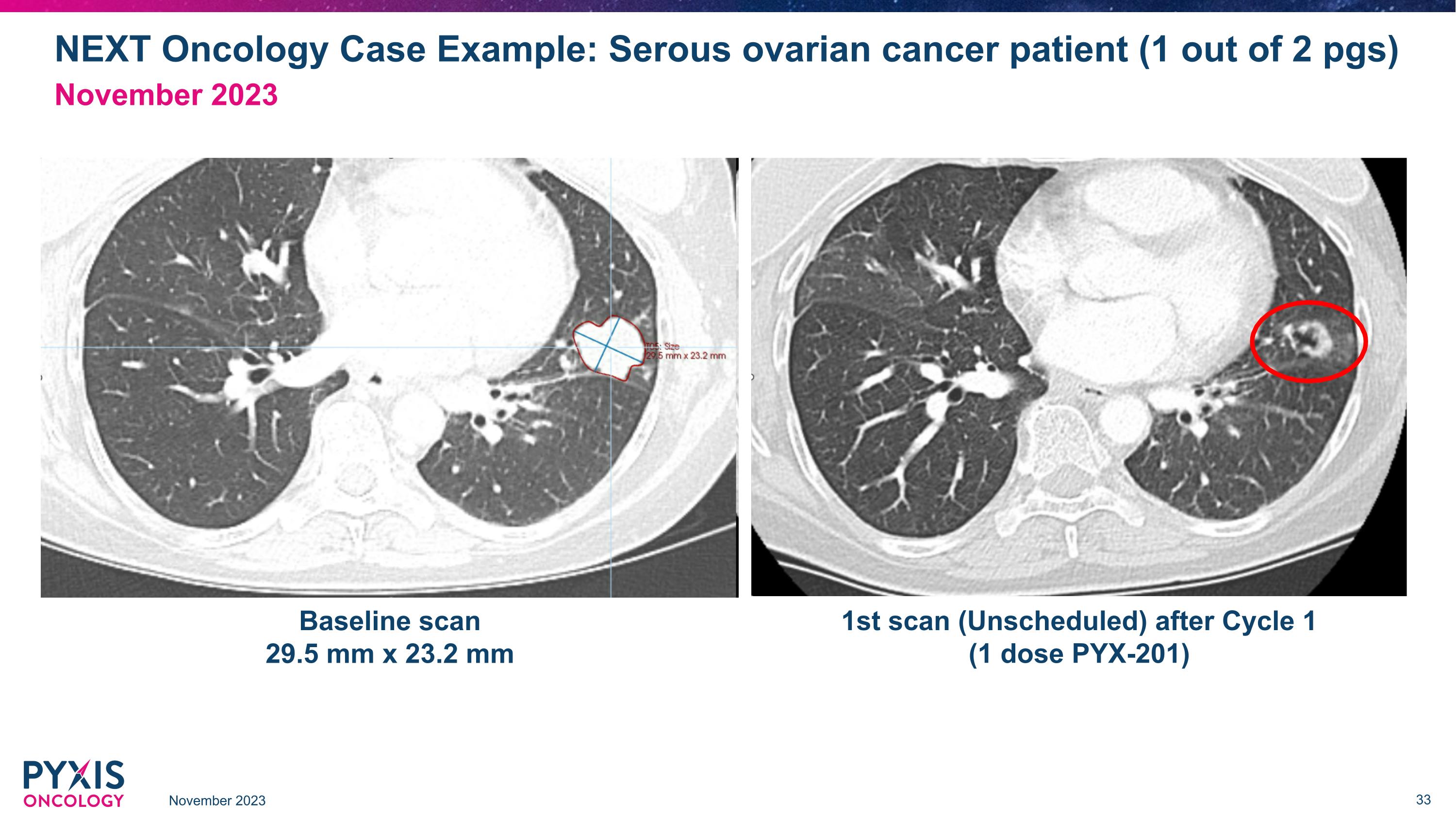
NEXT Oncology Case Example: Serous ovarian cancer patient (1 out of 2 pgs)�November 2023 November 2023 Baseline scan 29.5 mm x 23.2 mm 1st scan (Unscheduled) after Cycle 1 (1 dose PYX-201)
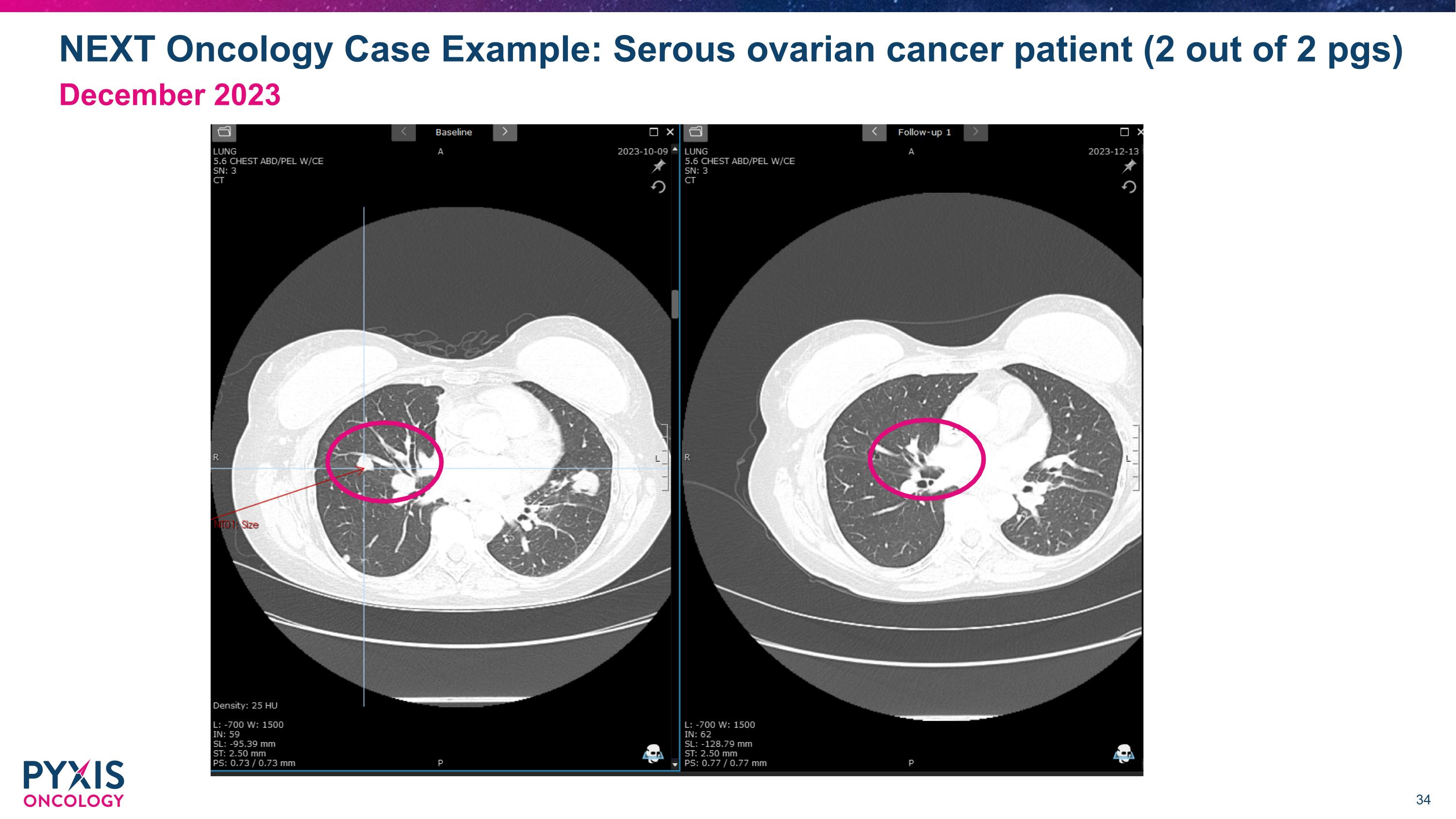
NEXT Oncology Case Example: Serous ovarian cancer patient (2 out of 2 pgs)�December 2023
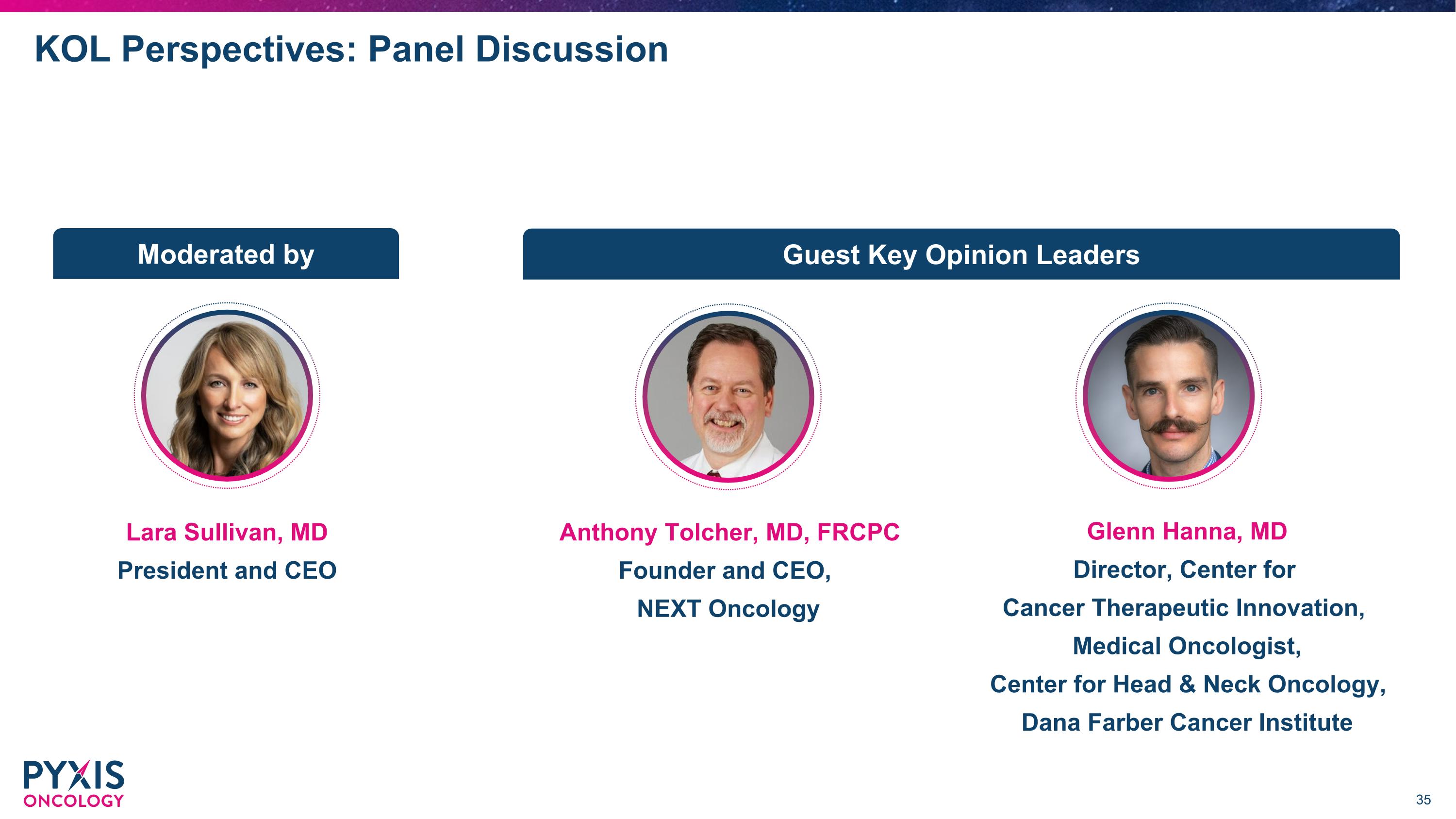
KOL Perspectives: Panel Discussion Lara Sullivan, MD President and CEO Moderated by Glenn Hanna, MD Director, Center for Cancer Therapeutic Innovation, Medical Oncologist, Center for Head & Neck Oncology, Dana Farber Cancer Institute Guest Key Opinion Leaders Anthony Tolcher, MD, FRCPC Founder and CEO, NEXT Oncology
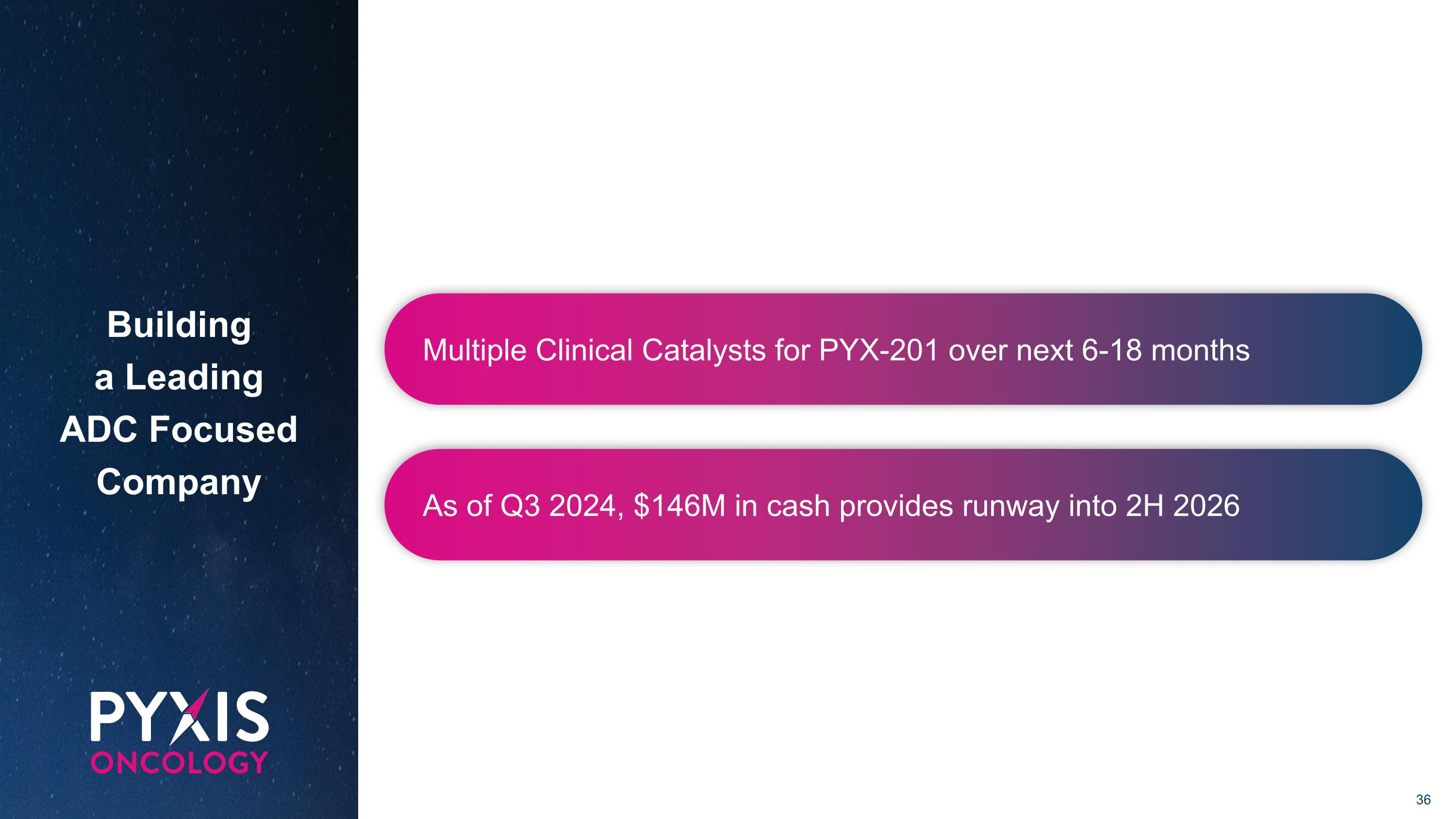
As of Q3 2024, $146M in cash provides runway into 2H 2026 Multiple Clinical Catalysts for PYX-201 over next 6-18 months Building �a Leading �ADC Focused Company
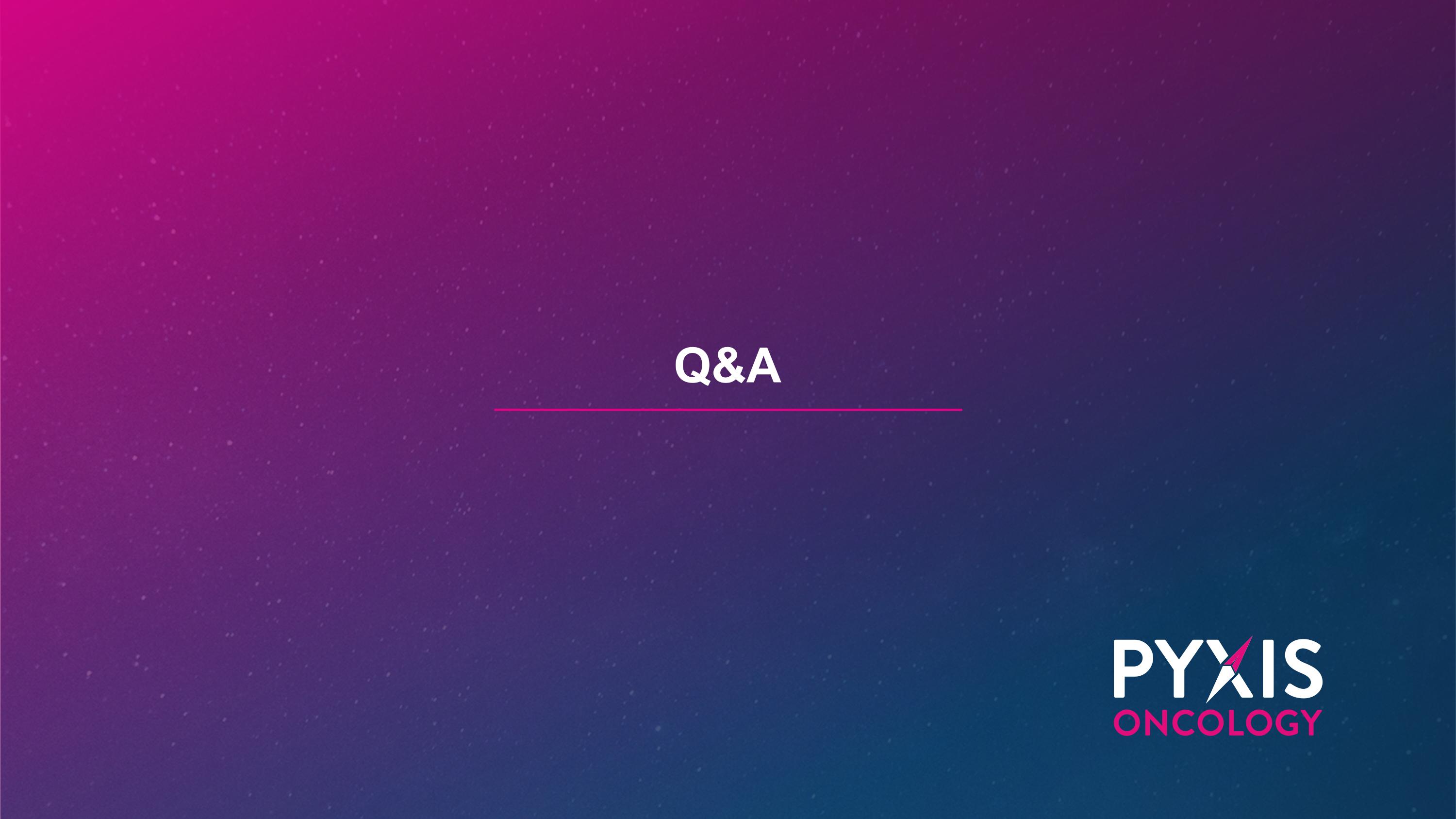
Q&A
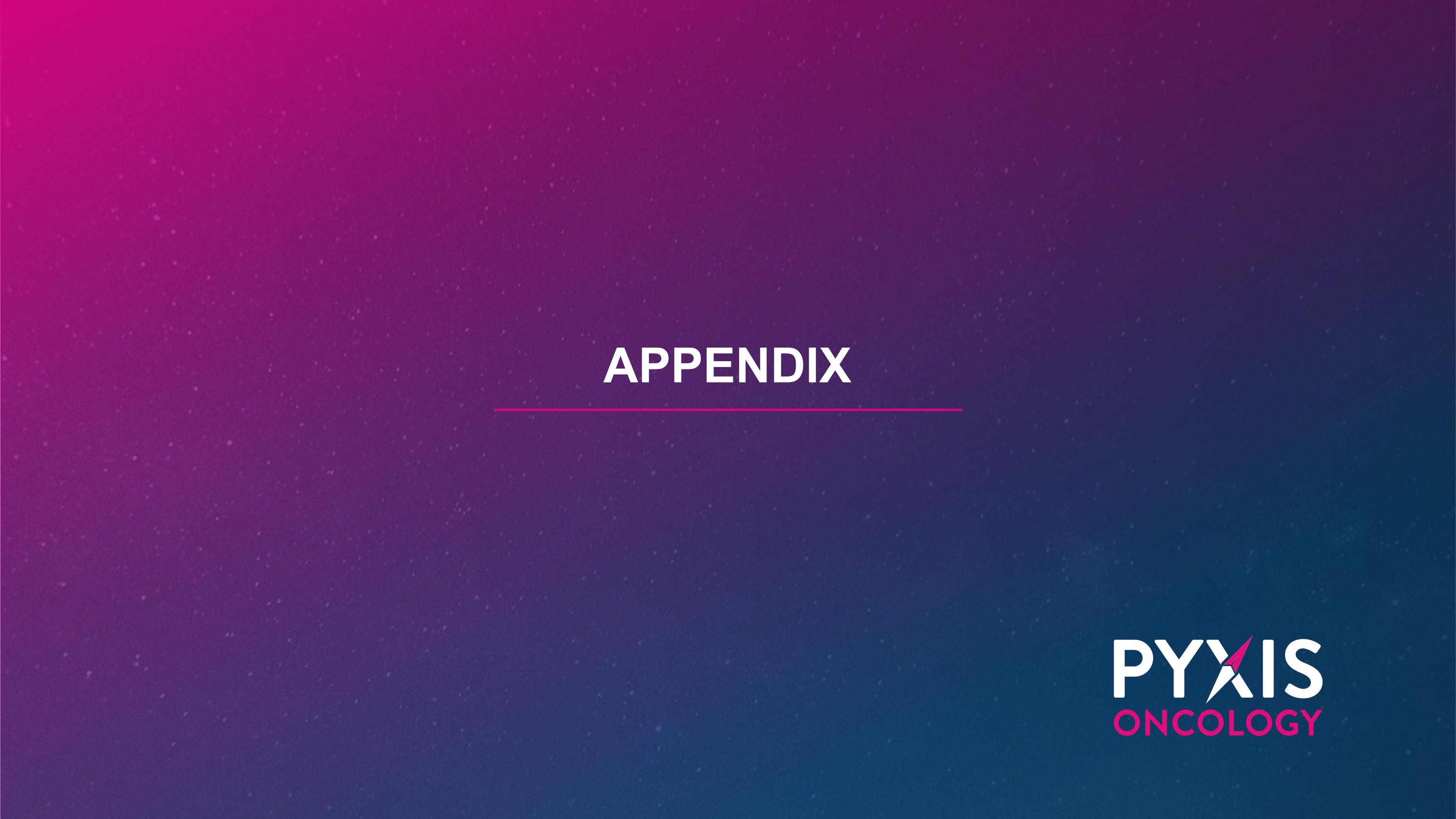
APPENDIX
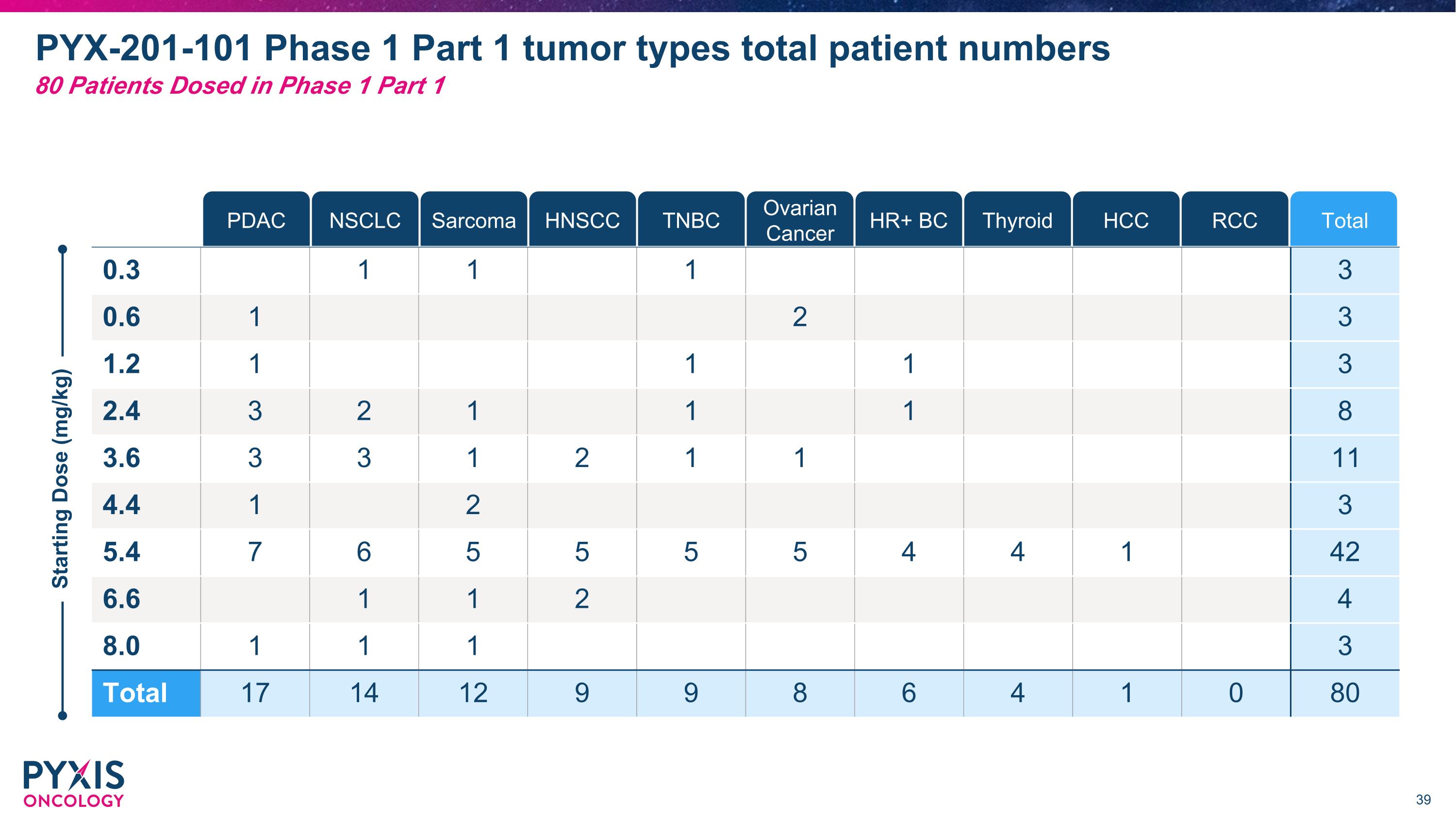
PYX-201-101 Phase 1 Part 1 tumor types total patient numbers 80 Patients Dosed in Phase 1 Part 1 0.3 1 1 1 3 0.6 1 2 3 1.2 1 1 1 3 2.4 3 2 1 1 1 8 3.6 3 3 1 2 1 1 11 4.4 1 2 3 5.4 7 6 5 5 5 5 4 4 1 42 6.6 1 1 2 4 8.0 1 1 1 3 Total 17 14 12 9 9 8 6 4 1 0 80 NSCLC TNBC Sarcoma HNSCC Ovarian Cancer PDAC HCC HR+ BC Thyroid RCC Total Starting Dose (mg/kg)
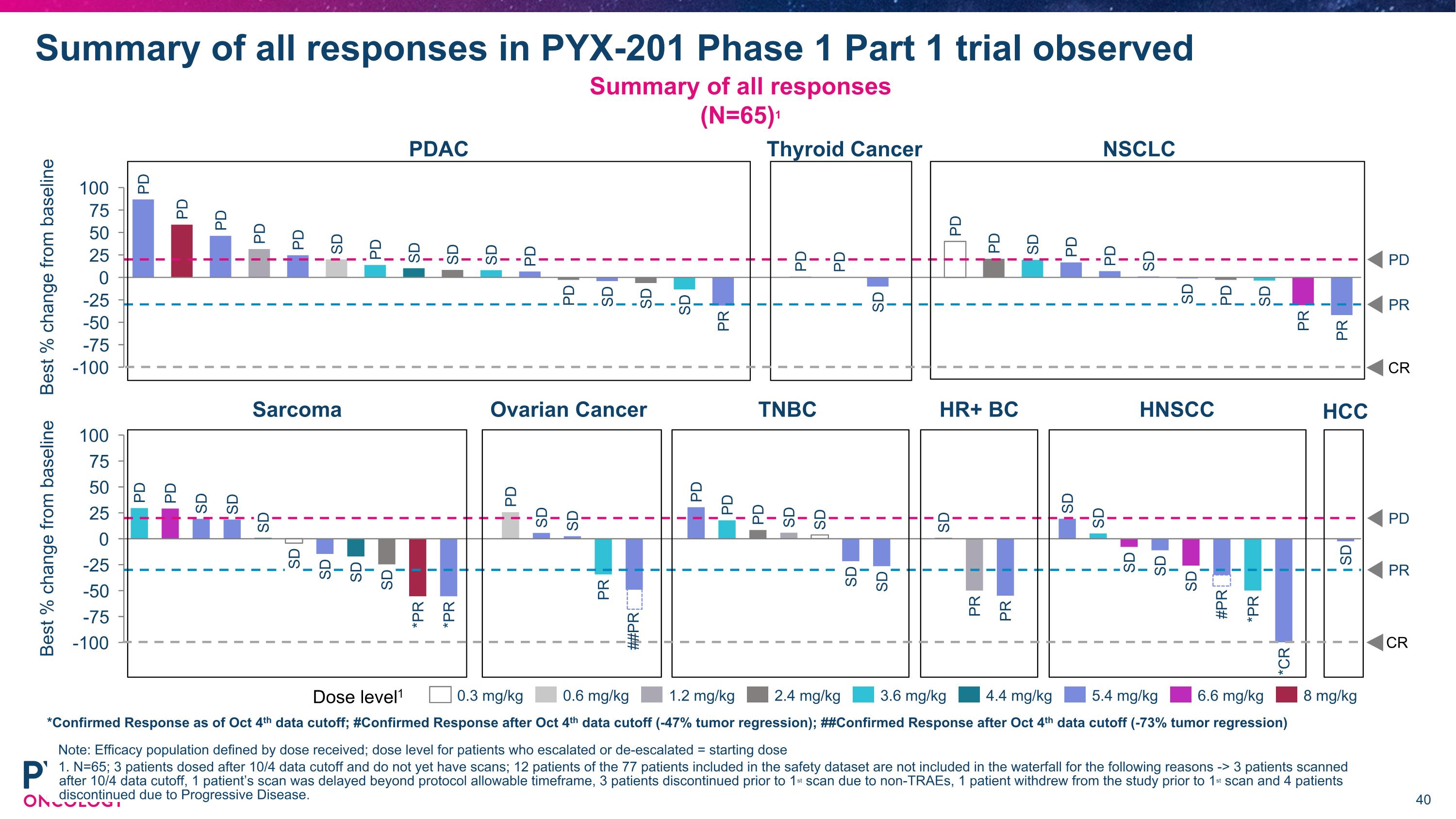
Summary of all responses in PYX-201 Phase 1 Part 1 trial observed Note: Efficacy population defined by dose received; dose level for patients who escalated or de-escalated = starting dose 1. N=65; 3 patients dosed after 10/4 data cutoff and do not yet have scans; 12 patients of the 77 patients included in the safety dataset are not included in the waterfall for the following reasons -> 3 patients scanned after 10/4 data cutoff, 1 patient’s scan was delayed beyond protocol allowable timeframe, 3 patients discontinued prior to 1st scan due to non-TRAEs, 1 patient withdrew from the study prior to 1st scan and 4 patients discontinued due to Progressive Disease. Summary of all responses (N=65)1 Best % change from baseline PD PR PD PD PD PD PD SD PD SD SD SD PD PD SD SD SD PR PD PD SD PD PD SD PD PD SD SD PD SD PR PR Dose level1 0.3 mg/kg 0.6 mg/kg 1.2 mg/kg 2.4 mg/kg 3.6 mg/kg 4.4 mg/kg 5.4 mg/kg 6.6 mg/kg 8 mg/kg PDAC Thyroid Cancer NSCLC CR *Confirmed Response as of Oct 4th data cutoff; #Confirmed Response after Oct 4th data cutoff (-47% tumor regression); ##Confirmed Response after Oct 4th data cutoff (-73% tumor regression) PR Best % change from baseline PD PD SD SD SD SD SD SD SD *PR *PR PD SD SD PR PD PD PD SD SD PD SD SD PR PR SD SD SD SD SD *PR *CR SD SD Sarcoma Ovarian Cancer TNBC HR+ BC HNSCC ##PR #PR CR HCC
Exhibit 99.2

Pyxis Oncology Announces Favorable Preliminary PYX-201 Clinical Phase 1 Part 1 Data
•PYX-201 achieved a confirmed 50% ORR by RECIST 1.1 including one Complete Response and 100% Disease Control Rate in six heavily pretreated HNSCC patients, supporting differentiated mono and front-line combo therapy expansion trials to begin dosing 1Q25
•Overall, 26% ORR across six Solid Tumor Types of Interest (n=31) with Dose Dependent Responses Observed, Supporting First-In-Concept Mechanism with Novel Extracellular Targeting ADC
•New Clinical Trial Collaboration Agreement with Merck (known as MSD outside of the US and Canada) to evaluate the combination of novel extracellular PYX-201 ADC and Merck’s anti-PD-1 therapy, KEYTRUDA® (pembrolizumab) to begin dosing 1Q25 in patients with HNSCC, HR+/HER2- breast, TNBC, and sarcoma
•PYX-201 generally well-tolerated with a favorable safety profile
•Multiple data updates expected in 2025
•Company to host in-person and virtual investor event today at 4:30 p.m. ET
BOSTON, November 20, 2024 -- Pyxis Oncology, Inc. (Nasdaq: PYXS), a clinical stage company focused on developing next generation therapeutics to target difficult-to-treat cancers, today announced positive preliminary data from the ongoing Phase 1 clinical dose escalation study evaluating PYX-201 in multiple types of solid tumors. PYX-201, the Company’s lead clinical drug candidate, is a first-in-concept antibody-drug conjugate (ADC) with a microtubule inhibitor (optimized auristatin) payload that uniquely targets Extradomain-B Fibronectin (EDB+FN), a non-cellular structural component within the tumor extracellular matrix (ECM).
"These positive data represent a significant milestone for Pyxis Oncology as our novel ECM-targeting ADC, PYX-201, has demonstrated clinical responses by RECIST 1.1 in six tumor types of interest: HNSCC, ovarian, NSCLC, HR+/HER2- breast, TNBC, and Sarcoma. The breadth and depth of our clinical responses clearly indicate the potential of PYX-201 to provide meaningful clinical benefits to patients with difficult-to-treat cancers," said Lara S. Sullivan, M.D., President and Chief Executive Officer of Pyxis Oncology. "In addition to the monotherapy expansion studies we are launching in 1Q25 in HNSCC, I am thrilled to announce our new Clinical Trial Collaboration Agreement with Merck (known as MSD outside of the US and Canada) to evaluate the combination of PYX-201 and Merck’s anti-PD-1 therapy, KEYTRUDA®
(pembrolizumab) in patients with HNSCC, HR+/HER2- breast, TNBC and Sarcoma with first patients expected to dose in 1Q25."
In this ongoing open-label, multicenter, dose-escalation Phase 1 trial of PYX-201, 80 patients have been enrolled and dosed across multiple solid tumor types to receive doses of PYX-201 ranging from 0.3 mg/kg up to 8.0 mg/kg. The trial's main objectives are to evaluate the safety, tolerability, pharmacokinetics, pharmacodynamics, and preliminary efficacy of PYX-201. The current identified dose range for PYX-201 is 3.6 mg/kg to 5.4 mg/kg. The number of prior lines of cancer therapies for patients enrolled is a median of 4 lines and up to 10 lines in some patients. The data cutoff date for this data announcement was October 4, 2024.
Preliminary Phase 1 Clinical Response Data in Patients with Head and Neck Squamous Cell Carcinoma (HNSCC):
Significant clinical responses were observed in HNSCC. Among evaluable HNSCC patients treated at an identified dose range of PYX-201 from 3.6 – 5.4 mg/kg (n=6), a confirmed 50% objective response rate (ORR) was observed, including one confirmed complete response (CR) and two confirmed partial responses (PR) by RECIST 1.1.
"These encouraging preliminary clinical data demonstrate the potential for PYX-201 to yield meaningful responses in heavily pretreated patients with head and neck cancer along with several additional solid tumor types," said Glenn J. Hanna, M.D., Director, Center for Cancer Therapeutic Innovation (Early Drug Development Program) and Center for Salivary and Rare Head and Neck Cancers at Dana-Farber Cancer Institute, and Associate Professor of Medicine, Harvard Medical School. "The patients in the study have endured multiple rounds of therapy before treatment with PYX-201. We believe the quantity and quality of the responses, including a complete response and PYX-201's tolerability profile, highlight its promising potential across multiple indications with high unmet medical need, particularly in head and neck cancer."
Clinical Trial Collaboration Agreement with Merck’s KEYTRUDA® (pembrolizumab)
The Company additionally announces that it has entered into a Clinical Trial Collaboration Agreement with Merck (known as MSD outside of the US and Canada), for a Pyxis Oncology-sponsored study of PYX-201 in combination with Merck’s anti-PD-1 therapy, KEYTRUDA® (pembrolizumab) in patients with 1L and 2L head and neck squamous cell carcinoma (HNSCC), HR+/HER2- breast cancer, and triple-negative breast cancer (TNBC) and sarcoma.
KEYTRUDA® is a registered trademark of Merck Sharp & Dohme LLC, a subsidiary of Merck & Co., Inc., Rahway, NJ, USA. Pyxis Oncology and Merck each retain all commercial rights to their respective compounds, including as monotherapy or as combination therapies.
PYX-201 Development Plans in Head and Neck Squamous Cell Carcinoma (HNSCC)
The Company expects to initiate the following HNSCC Phase 1 expansion studies:
•PYX-201 and KEYTRUDA® combination dose escalation and expansion study in 1L and 2L HNSCC with preliminary clinical data readout expected in the second half of 2025;
•PYX-201 monotherapy study in 2L and 3L HNSCC patients who are platinum and PD-1 inhibitor experienced, with preliminary clinical data readout expected in the second half of 2025; and
•PYX-201 monotherapy study in 2L and 3L HNSCC patients who are EGFR and PD-1 inhibitor experienced, with preliminary clinical data readout expected in first half of 2026.
Preliminary Phase 1 Clinical Response Data in Additional Solid Tumor Types:
Encouraging confirmed and unconfirmed responses were observed in five additional solid tumor types: ovarian cancer, non-small cell lung cancer (NSCLC), HR+/HER2- breast cancer, triple-negative breast cancer (TNBC), and sarcoma.
PYX-201 Development Plan in Additional Tumor Types
Exploratory PYX-201 Phase 1 monotherapy expansion cohorts are planned in ovarian cancer, NSCLC, HR+/HER2- breast cancer, TNBC, and sarcoma, with preliminary clinical data expected in the second half of 2025.
The Company also expects to initiate the following clinical combination studies:
•PYX-201 and KEYTRUDA® combination study in HR+/HER2- breast cancer, TNBC, and sarcoma with preliminary clinical data expected in the second half of 2025 and the first half of 2026.
•Preclinical studies of PYX-201 in combination with other agents in ovarian cancer and NSCLC to commence in 2025 to be followed by clinical studies with preliminary clinical data expected in 2026.
Summary of Preliminary Phase 1 Safety and Pharmacokinetics (PK) Data:
PYX-201 demonstrated favorable preliminary tolerability profile data with low incidence of dose discontinuation, interruptions or delays due to treatment-related adverse events (TRAE). Low incidence of Grade 3 or Grade 4 payload-related TRAEs within the identified dose range reinforce PYX-201’s differentiated construct enabling enhanced molecular stability and differential expression of Extradomain-B (EDB) in tumor tissue with negligible expression in normal tissues. The low incidence of Grade 1 or Grade 2 adverse events points to an attractive safety, given that it has been well tolerated and suitable for both monotherapy and combination therapy development.
With respect to PK data, PYX-201 demonstrated increased stability in circulation, which we believe is due to its proprietary design of site-specific conjugation chemistry as compared to certain approved val-cit-monomethyl auristatin E (MMAE) ADCs with non-site-specific conjugation chemistry.
"PYX-201 is an innovative investigational therapy designed with a unique extracellular mechanism of action, unlike any other ADC currently on the market or in development. These initial clinical data, demonstrating tumor shrinkage across a broad range of solid tumors with a differentiated safety profile indicate a significant opportunity to further develop PYX-201 across a variety of tumor types in both the mono and combo therapy settings," said Anthony Tolcher, M.D., FRCPC, FACP, Founder and Chief Executive Officer of NEXT Oncology and PYX-201 Study Investigator. "Additionally, the encouraging
safety data support the potential for PYX-201 to be safely combined with other agents, including checkpoint inhibitors, to drive further patient responses."
Additional details and analyses beyond what have been included in this press release will be presented during the Company's preliminary PYX-201 Phase 1 data investor event today.
In-person and Virtual Investor Event Information
Pyxis Oncology will host a virtual and in-person investor event to discuss the preliminary Phase 1 data today, Wednesday, November 20, 2024, at 4:30 p.m. ET at Venue 42 by Convene, located at 5 Times Square in New York City. Anyone interested in attending the live event should RSVP to .
Pyxis Oncology’s members of executive management team will be joined by the following physician thought leaders to discuss preliminary data from the Phase 1 trial:
•Anthony Tolcher, M.D., FRCPC, FACP, Founder and Chief Executive Officer, NEXT Oncology
•Glenn J. Hanna, M.D., Director, Center for Cancer Therapeutic Innovation (Early Drug Development Program) and Center for Salivary and Rare Head and Neck Cancers at Dana-Farber Cancer Institute, and Associate Professor of Medicine, Harvard Medical School
About Pyxis Oncology, Inc.
Pyxis Oncology, Inc. is a clinical stage company focused on defeating difficult-to-treat cancers. The company is efficiently building next generation therapeutics that hold the potential for mono and combination therapies. PYX-201, an antibody-drug conjugate (ADC) that uniquely targets EDB+FN, a non-cellular structural component of the tumor extracellular matrix, and PYX-106, a fully human Siglec-15-targeting antibody designed to block suppression of T-cell proliferation and function, are being evaluated in ongoing Phase 1 clinical studies in multiple types of solid tumors. Pyxis Oncology’s therapeutic candidates are designed to directly kill tumor cells and to address the underlying pathologies created by cancer that enable its uncontrollable proliferation and immune evasion. Pyxis Oncology’s ADC and immuno-oncology (IO) programs employ novel and emerging strategies to target a broad range of solid tumors resistant to current standards of care. To learn more, visit or follow us on (formerly known as Twitter) and .
Forward Looking Statements
This press release contain forward-looking statements for the purposes of the safe harbor provisions under The Private Securities Litigation Reform Act of 1995 and other federal securities laws. All statements other than statements of historical facts contained in this presentation and press release, including without limitation statements regarding the Company's plans to develop, manufacture and commercialize its product candidates, including PYX-201; initial results, timing and progress of the Company's ongoing clinical trials; the expected results of the Company's clinical trials; the ability of initial and topline clinical data to de-risk PYX-201 and be confirmed with clinical trial progression, including the safety, tolerability, and potential efficacy of PYX-201; the potential differentiation, advantage or effectiveness of PYX-201 compared to other approved products or products in development; the dosage and treatment potential of PYX-201; the size and future of the market; the plans and objectives of management, and the future results of operations and financial position of the Company, are

forward-looking statements. These statements are neither promises nor guarantees, but are statements that involve known and unknown risks, uncertainties and other important factors that are in some cases beyond the Company's control that may cause actual results, performance or achievements to be materially different from any future results, performance or achievements expressed or implied by the forward-looking statements, including, but not limited to, the following: the risks inherent in drug research and development, the Company's projected cash runway and potential needs for additional funding; the lengthy, expensive, and uncertain process of clinical drug development, including potential delays in or failure to obtain regulatory approvals; the Company's reliance on third parties and collaborators to conduct clinical trials, manufacture their product candidates, and develop and commercialize their product candidates; and the Company's ability compete successfully against other drug candidates. Accordingly, investors should not rely upon forward-looking statements as predictions of future events. Except as required by applicable law, the Company undertakes no obligation to update publicly or revise any forward-looking statements contained herein, whether as a result of any new information, future events, changed circumstances or otherwise.
Pyxis Oncology Contact
Pamela Connealy
CFO and COO
ir@pyxisoncology.com
v3.24.3
Document And Entity Information
|
Nov. 20, 2024 |
| Cover [Abstract] |
|
| Document Type |
8-K
|
| Amendment Flag |
false
|
| Document Period End Date |
Nov. 20, 2024
|
| Entity Registrant Name |
Pyxis Oncology, Inc.
|
| Entity Central Index Key |
0001782223
|
| Entity Emerging Growth Company |
true
|
| Entity File Number |
001-40881
|
| Entity Incorporation, State or Country Code |
DE
|
| Entity Tax Identification Number |
83-1160910
|
| Entity Address, Address Line One |
321 Harrison Avenue
|
| Entity Address, City or Town |
Boston
|
| Entity Address, State or Province |
MA
|
| Entity Address, Postal Zip Code |
02118
|
| City Area Code |
(617)
|
| Local Phone Number |
221-9059
|
| Entity Information, Former Legal or Registered Name |
|
| Written Communications |
false
|
| Soliciting Material |
false
|
| Pre-commencement Tender Offer |
false
|
| Pre-commencement Issuer Tender Offer |
false
|
| Entity Ex Transition Period |
true
|
| Title of 12(b) Security |
Common Stock, par value $0.001 per share
|
| Trading Symbol |
PYXS
|
| Security Exchange Name |
NASDAQ
|
| X |
- DefinitionBoolean flag that is true when the XBRL content amends previously-filed or accepted submission.
| Name: |
dei_AmendmentFlag |
| Namespace Prefix: |
dei_ |
| Data Type: |
xbrli:booleanItemType |
| Balance Type: |
na |
| Period Type: |
duration |
|
| X |
- DefinitionFor the EDGAR submission types of Form 8-K: the date of the report, the date of the earliest event reported; for the EDGAR submission types of Form N-1A: the filing date; for all other submission types: the end of the reporting or transition period. The format of the date is YYYY-MM-DD.
| Name: |
dei_DocumentPeriodEndDate |
| Namespace Prefix: |
dei_ |
| Data Type: |
xbrli:dateItemType |
| Balance Type: |
na |
| Period Type: |
duration |
|
| X |
- DefinitionThe type of document being provided (such as 10-K, 10-Q, 485BPOS, etc). The document type is limited to the same value as the supporting SEC submission type, or the word 'Other'.
| Name: |
dei_DocumentType |
| Namespace Prefix: |
dei_ |
| Data Type: |
dei:submissionTypeItemType |
| Balance Type: |
na |
| Period Type: |
duration |
|
| X |
- DefinitionAddress Line 1 such as Attn, Building Name, Street Name
| Name: |
dei_EntityAddressAddressLine1 |
| Namespace Prefix: |
dei_ |
| Data Type: |
xbrli:normalizedStringItemType |
| Balance Type: |
na |
| Period Type: |
duration |
|
| X |
- Definition
+ References
+ Details
| Name: |
dei_EntityAddressCityOrTown |
| Namespace Prefix: |
dei_ |
| Data Type: |
xbrli:normalizedStringItemType |
| Balance Type: |
na |
| Period Type: |
duration |
|
| X |
- DefinitionCode for the postal or zip code
| Name: |
dei_EntityAddressPostalZipCode |
| Namespace Prefix: |
dei_ |
| Data Type: |
xbrli:normalizedStringItemType |
| Balance Type: |
na |
| Period Type: |
duration |
|
| X |
- DefinitionName of the state or province.
| Name: |
dei_EntityAddressStateOrProvince |
| Namespace Prefix: |
dei_ |
| Data Type: |
dei:stateOrProvinceItemType |
| Balance Type: |
na |
| Period Type: |
duration |
|
| X |
- DefinitionA unique 10-digit SEC-issued value to identify entities that have filed disclosures with the SEC. It is commonly abbreviated as CIK. Reference 1: http://www.xbrl.org/2003/role/presentationRef
-Publisher SEC
-Name Exchange Act
-Number 240
-Section 12
-Subsection b-2
| Name: |
dei_EntityCentralIndexKey |
| Namespace Prefix: |
dei_ |
| Data Type: |
dei:centralIndexKeyItemType |
| Balance Type: |
na |
| Period Type: |
duration |
|
| X |
- DefinitionIndicate if registrant meets the emerging growth company criteria. Reference 1: http://www.xbrl.org/2003/role/presentationRef
-Publisher SEC
-Name Exchange Act
-Number 240
-Section 12
-Subsection b-2
| Name: |
dei_EntityEmergingGrowthCompany |
| Namespace Prefix: |
dei_ |
| Data Type: |
xbrli:booleanItemType |
| Balance Type: |
na |
| Period Type: |
duration |
|
| X |
- DefinitionCommission file number. The field allows up to 17 characters. The prefix may contain 1-3 digits, the sequence number may contain 1-8 digits, the optional suffix may contain 1-4 characters, and the fields are separated with a hyphen.
| Name: |
dei_EntityFileNumber |
| Namespace Prefix: |
dei_ |
| Data Type: |
dei:fileNumberItemType |
| Balance Type: |
na |
| Period Type: |
duration |
|
| X |
- DefinitionTwo-character EDGAR code representing the state or country of incorporation.
| Name: |
dei_EntityIncorporationStateCountryCode |
| Namespace Prefix: |
dei_ |
| Data Type: |
dei:edgarStateCountryItemType |
| Balance Type: |
na |
| Period Type: |
duration |
|
| X |
- DefinitionThe exact name of the entity filing the report as specified in its charter, which is required by forms filed with the SEC. Reference 1: http://www.xbrl.org/2003/role/presentationRef
-Publisher SEC
-Name Exchange Act
-Number 240
-Section 12
-Subsection b-2
| Name: |
dei_EntityRegistrantName |
| Namespace Prefix: |
dei_ |
| Data Type: |
xbrli:normalizedStringItemType |
| Balance Type: |
na |
| Period Type: |
duration |
|
| X |
- DefinitionThe Tax Identification Number (TIN), also known as an Employer Identification Number (EIN), is a unique 9-digit value assigned by the IRS. Reference 1: http://www.xbrl.org/2003/role/presentationRef
-Publisher SEC
-Name Exchange Act
-Number 240
-Section 12
-Subsection b-2
| Name: |
dei_EntityTaxIdentificationNumber |
| Namespace Prefix: |
dei_ |
| Data Type: |
dei:employerIdItemType |
| Balance Type: |
na |
| Period Type: |
duration |
|
| X |
- DefinitionLocal phone number for entity.
| Name: |
dei_LocalPhoneNumber |
| Namespace Prefix: |
dei_ |
| Data Type: |
xbrli:normalizedStringItemType |
| Balance Type: |
na |
| Period Type: |
duration |
|
| X |
- DefinitionBoolean flag that is true when the Form 8-K filing is intended to satisfy the filing obligation of the registrant as pre-commencement communications pursuant to Rule 13e-4(c) under the Exchange Act. Reference 1: http://www.xbrl.org/2003/role/presentationRef
-Publisher SEC
-Name Exchange Act
-Number 240
-Section 13e
-Subsection 4c
| Name: |
dei_PreCommencementIssuerTenderOffer |
| Namespace Prefix: |
dei_ |
| Data Type: |
xbrli:booleanItemType |
| Balance Type: |
na |
| Period Type: |
duration |
|
| X |
- DefinitionBoolean flag that is true when the Form 8-K filing is intended to satisfy the filing obligation of the registrant as pre-commencement communications pursuant to Rule 14d-2(b) under the Exchange Act. Reference 1: http://www.xbrl.org/2003/role/presentationRef
-Publisher SEC
-Name Exchange Act
-Number 240
-Section 14d
-Subsection 2b
| Name: |
dei_PreCommencementTenderOffer |
| Namespace Prefix: |
dei_ |
| Data Type: |
xbrli:booleanItemType |
| Balance Type: |
na |
| Period Type: |
duration |
|
| X |
- DefinitionTitle of a 12(b) registered security. Reference 1: http://www.xbrl.org/2003/role/presentationRef
-Publisher SEC
-Name Exchange Act
-Number 240
-Section 12
-Subsection b
| Name: |
dei_Security12bTitle |
| Namespace Prefix: |
dei_ |
| Data Type: |
dei:securityTitleItemType |
| Balance Type: |
na |
| Period Type: |
duration |
|
| X |
- DefinitionName of the Exchange on which a security is registered. Reference 1: http://www.xbrl.org/2003/role/presentationRef
-Publisher SEC
-Name Exchange Act
-Number 240
-Section 12
-Subsection d1-1
| Name: |
dei_SecurityExchangeName |
| Namespace Prefix: |
dei_ |
| Data Type: |
dei:edgarExchangeCodeItemType |
| Balance Type: |
na |
| Period Type: |
duration |
|
| X |
- DefinitionBoolean flag that is true when the Form 8-K filing is intended to satisfy the filing obligation of the registrant as soliciting material pursuant to Rule 14a-12 under the Exchange Act. Reference 1: http://www.xbrl.org/2003/role/presentationRef
-Publisher SEC
-Name Exchange Act
-Number 240
-Section 14a
-Subsection 12
| Name: |
dei_SolicitingMaterial |
| Namespace Prefix: |
dei_ |
| Data Type: |
xbrli:booleanItemType |
| Balance Type: |
na |
| Period Type: |
duration |
|
| X |
- DefinitionTrading symbol of an instrument as listed on an exchange.
| Name: |
dei_TradingSymbol |
| Namespace Prefix: |
dei_ |
| Data Type: |
dei:tradingSymbolItemType |
| Balance Type: |
na |
| Period Type: |
duration |
|
| X |
- DefinitionBoolean flag that is true when the Form 8-K filing is intended to satisfy the filing obligation of the registrant as written communications pursuant to Rule 425 under the Securities Act. Reference 1: http://www.xbrl.org/2003/role/presentationRef
-Publisher SEC
-Name Securities Act
-Number 230
-Section 425
| Name: |
dei_WrittenCommunications |
| Namespace Prefix: |
dei_ |
| Data Type: |
xbrli:booleanItemType |
| Balance Type: |
na |
| Period Type: |
duration |
|
Pyxis Oncology (NASDAQ:PYXS)
Historical Stock Chart
Von Dez 2024 bis Jan 2025
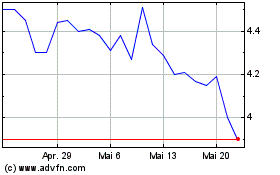
Pyxis Oncology (NASDAQ:PYXS)
Historical Stock Chart
Von Jan 2024 bis Jan 2025
